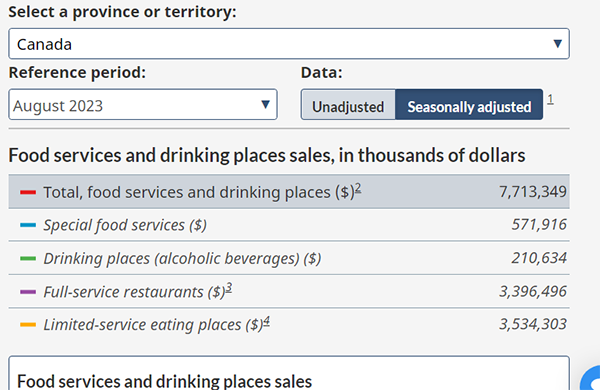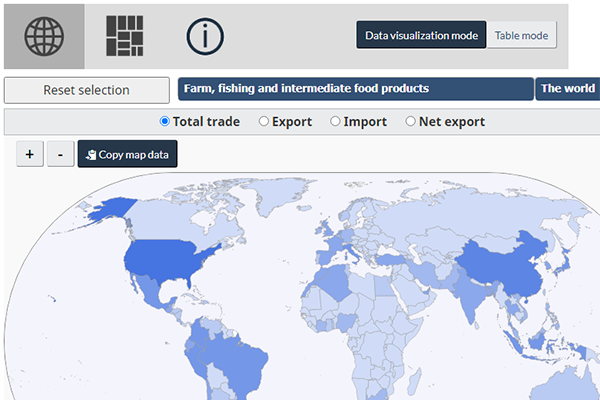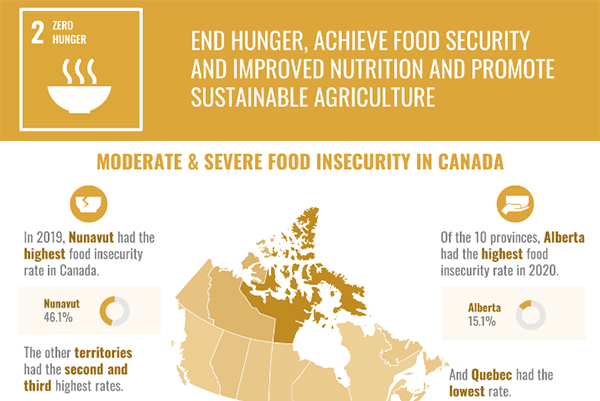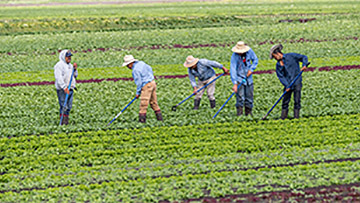Canada's Core Public Infrastructure Survey 2022
Why are we conducting this survey?
Statistics Canada is undertaking this survey to provide useful statistical information on the stock, condition, performance and asset management strategies of Canada's core public infrastructure assets owned or leased by the various levels of government and Indigenous entities.
The information compiled by this survey will be used by analysts and policy-makers to better understand the current condition of Canada's core infrastructure. This will enable all levels of government to develop policies to support the efforts in improving Canada's core public infrastructure and help monitor and report progress on achievement of desired outcomes.
Your information may also be used by Statistics Canada for other statistical and research purposes.
Other important information
Authorization to collect this information.
Data are collected under the authority of the Statistics Act, Revised Statutes of Canada, 1985, Chapter S-19.
Confidentiality
By law, Statistics Canada is prohibited from releasing any information it collects that could identify any person, business, or organization, unless consent has been given by the respondent, or as permitted by the Statistics Act. Statistics Canada will use the information from this survey for statistical purposes only.
Approved Disclosure
Section 17 of the federal Statistics Act allows for the disclosure of certain information relating to an individual, business or organization. Statistics Canada will only disclose information where there is a demonstrated statistical need and for the public good, and when it will not harm individuals, organizations or businesses if data were disclosed. For Canada's Core Public Infrastructure Survey, the Chief Statistician has authorized the release of data relating to individual government entities and public utilities. These include data on assets at the aggregate and individual level. Additionally, the names of provincial, regional and municipal government organizations will be released, as well as the variables used in sampling and estimation.
Record linkages
To enhance the data from this survey and to reduce the reporting burden, Statistics Canada may combine the acquired data with information from other surveys or from administrative sources.
Data-sharing agreements
To reduce respondent burden, Statistics Canada has entered into data-sharing agreements with provincial and territorial statistical agencies and other government organizations, which have agreed to keep the data confidential and use them only for statistical purposes. Statistics Canada will only share data from this survey with those organizations that have demonstrated a requirement to use the data.
Section 11 of the Statistics Act provides for the sharing of information with provincial and territorial statistical agencies that meet certain conditions. These agencies must have the legislative authority to collect the same information, on a mandatory basis, and the legislation must provide substantially the same provisions for confidentiality and penalties for disclosure of confidential information as the Statistics Act. Because these agencies have the legal authority to compel businesses to provide the same information, consent is not requested and businesses may not object to the sharing of the data.
For this survey, there are Section 11 agreements with the provincial and territorial statistical agencies of Newfoundland and Labrador, Nova Scotia, New Brunswick, Quebec, Ontario, Manitoba, Saskatchewan, Alberta, British Columbia and the Yukon. The shared data will be limited to information pertaining to business establishments located within the jurisdiction of the respective province or territory.
Section 12 of the Statistics Act provides for the sharing of information with federal, provincial or territorial government organizations. Under Section 12, you may refuse to share your information with any of these organizations by writing a letter of objection to the Chief Statistician, specifying the organizations with which you do not want Statistics Canada to share your data and mailing it to the following address:
Chief Statistician of Canada
Statistics Canada
Attention Director of, Centre for Production, Distribution and Investment Statistics
150 Tunney's Pasture Driveway
Ottawa, Ontario
K1A 0T6
For this survey, there are Section 12 agreements with the statistical agencies of Prince Edward Island, Northwest Territories and Nunavut, as well as with Infrastructure Canada.
For agreements with provincial and territorial government organizations, the shared data will be limited to information pertaining to business establishments located within the jurisdiction of the respective province or territory.
Reporting period
For the purposes of this survey, report information for the 12-month period ending December 31, 2022. If your 12-month fiscal period has not yet ended, provide your best estimate for the entire year.
Reporting instructions
- Report dollar amounts in thousands of Canadian dollars.
- Report distances or lengths in kilometers.
- Report counts in whole numbers.
- Percentages should be rounded to whole numbers.
- When precise figures are not available, provide your best estimates.
- Enter '0' if there is no value to report.
Who should complete this questionnaire?
This questionnaire should be completed by the asset manager.
Deadline for completing this questionnaire.
Please complete this questionnaire and submit it within 30 days of receipt.
Canada's Core Infrastructure Survey, 2022
Ownership
Non-Linear Assets: assets that can't be measured in linear units (feet, metres) and have one specific address or location. Examples include: wastewater treatment plants, pump stations and water drainage pump stations.
Linear Assets: assets that can be measured in linear units (feet, metres) and do not have one specific address. Examples include: open ditches, local water pipes and sewer pipes.
1. In 2022, did your organization own or lease any potable water assets?
Non-linear potable water system assets
- Yes
- No
List any other municipalities or organizations that provided your organization with any non-linear potable water services in 2022.
- Specify alternate linear potable water system provider 1
- Specify alternate linear potable water system provider 2
- Specify alternate linear potable water system provider 3
Linear potable water system assets
- Yes
- No
List any other municipalities or organizations that provided your organization with any linear potable water services in 2022.
- Specify alternate non-linear potable water system provider 1
- Specify alternate non-linear potable water system provider 2
- Specify alternate non-linear potable water system provider 3
2. In 2022, did your organization own or lease any wastewater assets?
Non-linear wastewater system assets
- Yes
- No
List any other municipalities or organizations that provided your organization with any non-linear wastewater services in 2022.
- Specify alternate non-linear wastewater system provider 1
- Specify alternate non-linear wastewater system provider 2
- Specify alternate non-linear wastewater system provider 3
Linear wastewater system assets
- Yes
- No
List any other municipalities or organizations that provided your organization with any linear wastewater services in 2022.
- Specify alternate non-linear wastewater system provider 1
- Specify alternate non-linear wastewater system provider 2
- Specify alternate non-linear wastewater system provider 3
3. In 2022, did your organization own or lease any stormwater assets?
- Yes
- No
Non-linear stormwater system assets
List any other municipalities or organizations that provided your organization with any non-linear stormwater services in 2022.
- Specify alternate non-linear stormwater system provider 1
- Specify alternate non-linear stormwater system provider 2
- Specify alternate non-linear stormwater system provider 3
Linear stormwater system assets
- Yes
- No
List any other municipalities or organizations that provided your organization with any linear stormwater services in 2022.
- Specify alternate linear stormwater system provider 1
- Specify alternate linear stormwater system provider 2
- Specify alternate linear stormwater system provider 3
4. In 2022, did your organization own or lease any road assets?
- Yes
- No
List any other municipalities or organizations that provided your organization with any road services in 2022.
- Specify alternate non-linear road system provider 1
- Specify alternate non-linear road system provider 2
- Specify alternate non-linear road system provider 3
5. In 2022, did your organization own or lease any bridge and tunnel assets?
- Yes
- No
List any other municipalities or organizations that provided your organization with any bridge and tunnel services in 2022.
- Specify alternate non-linear bridge and tunnel system provider 1
- Specify alternate non-linear bridge and tunnel system provider 2
- Specify alternate non-linear bridge and tunnel system provider 3
6. In 2022, did your organization own or lease any solid waste assets?
Solid waste collection assets
- Yes
- No
List any other municipalities or organizations that provided your organization with any solid waste collection services in 2022.
- Specify alternate solid waste collection provider 1
- Specify alternate solid waste collection provider 2
- Specify alternate solid waste collection provider 3
Solid waste transfer station assets
- Yes
- No
List any other municipalities or organizations that provided your organization with any solid waste transfer station services in 2022.
- Specify alternate solid waste transfer station provider 1
- Specify alternate solid waste transfer station provider 2
- Specify alternate solid waste transfer station provider 3
Solid waste diversion assets
- Yes
- No
List any other municipalities or organizations that provided your organization with any solid waste diversion services in 2022.
- Specify alternate solid waste diversion provider 1
- Specify alternate solid waste diversion provider 2
- Specify alternate solid waste diversion provider 3
Solid waste disposal assets
- Yes
- No
List any other municipalities or organizations that provided your organization with any solid waste disposal services in 2022.
- Specify alternate solid waste disposal provider 1
- Specify alternate solid waste disposal provider 2
- Specify alternate solid waste disposal provider 3
7. In 2022, did your organization own or lease any culture, recreation and sport facilities?
- Yes
- No
List any other municipalities or organizations that had a formal arrangement to provide your organization with any culture, recreation and sports facilities in 2022.
- Specify alternate culture, recreation and sport facilities provider 1
- Specify alternate culture, recreation and sport facilities provider 2
- Specify alternate culture, recreation and sport facilities provider 3
8. In 2022, did your organization own or lease any public transit assets?
- Yes
- No
List any other municipalities or organizations that provided your organization with any public transit services in 2022.
- Specify alternate public transit provider 1
- Specify alternate public transit provider 2
- Specify alternate public transit provider 3
9. In 2022, did your organization own or lease any active transportation assets?
- Yes
- No
List any other municipalities or organizations that provided your organization with any active transportation services in 2022.
- Specify alternate active transportation provider 1
- Specify alternate active transportation provider 2
- Specify alternate active transportation provider 3
10. In 2022, did your organization own or lease any natural infrastructure assets?
- Yes
- No
List any other municipalities or organizations (e.g., Indigenous groups or partners) that had a formal arrangement to provide your organization with any natural infrastructure services in 2022.
- Specify alternate natural infrastructure provider 1
- Specify alternate natural infrastructure provider 2
- Specify alternate natural infrastructure provider 3
11. In 2022, did your organization own or lease any shelter and homeless service assets?
- Yes
- No
List any other municipalities or organizations that provided your organization with any shelters and homeless services in 2022.
- Specify alternate shelter and homeless service provider 1
- Specify alternate shelter and homeless service provider 2
- Specify alternate shelter and homeless service provider 3
12. In 2022, did your organization own or lease any public social and affordable housing assets?
- Yes
- No
List any other municipalities or organizations that provided your organization with any public social and affordable housing services in 2022.
- Specify alternate public social and affordable housing provider 1
- Specify alternate public social and affordable housing provider 2
- Specify alternate public social and affordable housing provider 3
Potable Water
Non-Linear Assets: assets that can't be measured in linear units (feet, metres) and have one specific address or location. Examples include: wastewater treatment plants, pump stations and water drainage pump stations.
Linear Assets: assets that can be measured in linear units (feet, metres) and do not have one specific address. Examples include: open ditches, local water pipes and sewer pipes.
13. What was your organization's final inventory count of potable water assets as of December 31, 2022?
Provide your best estimate when exact figures are not available.
Report "0" when the organization does not own or lease the asset.
Non-linear potable water assets
a. Water treatment facilities
Count
Capacity (volume) cubic metres per day
b. Water storage assets
Count
Capacity (volume) cubic metres
c. Water pump stations
Count
Capacity (volume) cubic metres per day
Linear potable water assets (Indicate length in kilometres)
d. Local water pipes (diameter less than 416 mm)
Count
e. Transmission pipes (diameter greater than or equal to 416 mm)
Count
f. Pipes of unknown diameter
Count
14. Of the reported count for reported water storage assets in question 13b, how many were before the intake of a treatment plant?
Count
15. Provide the distribution of your organization's potable water assets inventory based on the year of completed construction below.
Provide your best estimate when exact figures are not available.
Report "0" when the organization does not own or lease the asset.
Non-linear potable water assets
a. Water treatment facilities
- 2020 - 2022
- 2010 - 2019
- 2000 – 2009
- 1970 – 1999
- 1940 - 1969
- Prior to 1940
b. Water storage assets
- 2020 - 2022
- 2010 - 2019
- 2000 – 2009
- 1970 – 1999
- 1940 - 1969
- Prior to 1940
c. Water pump stations
- 2020 - 2022
- 2010 - 2019
- 2000 – 2009
- 1970 – 1999
- 1940 - 1969
- Prior to 1940
Linear potable water assets (Indicate length in kilometres)
d. Local water pipes (diameter less than 416 mm)
- 2020 - 2022
- 2010 - 2019
- 2000 – 2009
- 1970 – 1999
- 1940 - 1969
- Prior to 1940
e. Transmission pipes (diameter greater than or equal to 416 mm)
- 2020 - 2022
- 2010 - 2019
- 2000 – 2009
- 1970 – 1999
- 1940 - 1969
- Prior to 1940
f. Pipes of unknown diameter
- 2020 - 2022
- 2010 - 2019
- 2000 – 2009
- 1970 – 1999
- 1940 - 1969
- Prior to 1940
16. In 2022, what was the overall physical condition of your organization's potable water assets?
Indicate the percent distribution of your assets by using the condition rating scale. This includes items to be decommissioned. Each reporting asset must total to 100%.
Non-linear potable water assets
a. Water treatment facilities
- Very Poor
- Poor
- Fair
- Good
- Very Good
- Do not know
b. Water storage assets
- Very Poor
- Poor
- Fair
- Good
- Very Good
- Do not know
c. Water pump stations
- Very Poor
- Poor
- Fair
- Good
- Very Good
- Do not know
Linear potable water assets
d. Local water pipes (diameter less than 416 mm)
- Very Poor
- Poor
- Fair
- Good
- Very Good
- Do not know
e. Transmission pipes (diameter greater than or equal to 416 mm)
- Very Poor
- Poor
- Fair
- Good
- Very Good
- Do not know
f. Pipes of unknown diameter
- Very Poor
- Poor
- Fair
- Good
- Very Good
- Do not know
17. What is the 2022 estimated replacement value, required renewal budget, and actual renewal budget of potable water assets owned by your organization?
Provide your best estimate when exact figures are not available.
Report "0" when the organization does not own or lease the asset.
If a breakdown is not available, please provide the total.
Please report all amounts in thousands of Canadian dollars.
Non-linear potable water assets
a. Water treatment facilities
- Estimated Replacement Value
- Required Renewal Budget
- Actual Renewal Budget
b. Water storage assets
- Estimated Replacement Value
- Required Renewal Budget
- Actual Renewal Budget
c. Water pump stations
- Estimated Replacement Value
- Required Renewal Budget
- Actual Renewal Budget
Total for all non-linear potable water assets
- Estimated Replacement Value
- Required Renewal Budget
- Actual Renewal Budget
Linear potable water assets (Indicate length in kilometres)
d. Local water pipes (diameter less than 416 mm)
- Estimated Replacement Value
- Required Renewal Budget
- Actual Renewal Budget
e. Transmission pipes (diameter greater than or equal to 416 mm)
- Estimated Replacement Value
- Required Renewal Budget
- Actual Renewal Budget
f. Pipes of unknown diameter
- Estimated Replacement Value
- Required Renewal Budget
- Actual Renewal Budget
Total for all linear potable water assets
- Estimated Replacement Value
- Required Renewal Budget
- Actual Renewal Budget
18. In 2022, did your organization acquire or bring into service any new potable water assets for the following categories? For the new assets acquired, please provide the expected useful life.
Indicate the useful life (in years) for new assets acquired or brought into service during the year.
Non-linear potable water assets
a. Water treatment facilities
Expected Useful Life (in Years)
b. Water storage assets
Expected Useful Life (in Years)
c. Water pump stations
Expected Useful Life (in Years)
Linear potable water assets
d. Local water pipes (diameter less than 416 mm)
Expected Useful Life (in Years)
e. Transmission pipes (diameter greater than or equal to 416 mm)
Expected Useful Life (in Years)
f. Pipes of unknown diameter
Expected Useful Life (in Years)
19. How many sustained boil water advisories were in place on December 31, 2022?
Note: Sustained boil water advisory: A boil water advisory exceeding 15 days in duration.
Number of sustained water advisories
Do not know
20. Of the number of sustained boil water advisories, how many were in place for:
a. Over five years
Number
b. Over one year
Number
c. Over six months
Number
21. In 2022, what were the volumetric flow rates of your organizations linear potable water assets?
Indicate the percentage distribution of your assets.
a. Less than 99 litres per second
Percentage of linear potable water assets
b. Between 100 litres per second and 399 litres per second
Percentage of linear potable water assets
c. Greater than 400 litres per second
Percentage of linear potable water assets
22. In 2022, how many major leaks or bursts were repaired?
a. Watermains
Count
b. Service lines
Count
23. Of the major leaks or bursts reported on question 22, what is the average number of days between detection and repair?
a. Watermains
Number of days
b. Service lines
Number of days
24. What was the length in kilometres of asbestos cement water pipes as of December 31, 2022?
Total length in kilometres
25. Does your organization have an inventory of the number of lead water service connections or lead water pipes?
If "yes" please answer the sub questions below.
If "no" go to question 26.
What was the total amount of lead water service connections or lead water service pipes as of December 31, 2022?
Count
What percentage of your organization's service connections or pipes contained lead in 2022?
Percentage
Does your organization's inventory of lead service connections or lead water pipes identify partial lead service connections (homeowner or municipal)?
- Yes
- No
What percentage of your organization's inventory of lead service connections or lead water pipes was identified as full service connections (i.e., municipal and homeowner portions) in 2022?
Percentage
26. Did your organization have a lead service line replacement program in place in 2022?
If "yes" please answer the sub questions below.
Did the program address both the municipal and homeowner portions of the replacement?
- Yes
- No
Did the program include incentives or loans to the homeowner to replace their portion of the lead service connection?
- Yes
- No
When was this program implemented?
Date (example: YYYY-MM-DD)
What was the budget for this program?
Budget CAN$ '000
If "no" What were the identified barriers for implementing such a program?
Specify the barriers
27. What percentage of the inventory of lead service connections or lead pipes was replaced in 2022?
Percentage
28. Of the lead service connections or lead water pipes replaced in 2022, what percentage was full replacement (i.e., municipal and homeowner portions)?
Percentage
29. What was the cost of the lead service connections or lead water pipes was replaced in 2022?
Cost CAN$ '000
30. Did your organization have a corrosion control program in place in 2022?
- Yes
- No
31. Does your organization have the resources or capacity to track information regarding lead service connections or the lead concentrations in tap water?
- Yes
- No
32. Did your organization conduct sampling to measure lead concentrations in tap water in 2022?
If "yes" please answer the sub questions below.
If "no" go to question 33.
What percentage of the most recent lead concentration results was sampled in residences supplied by a lead water service connection?
Percentage
What was the average lead concentration for samples taken in residences supplied by a lead service connection?
Concentration (micrograms per litre or µg/L)
33. Does your organization have a documented asset management plan for potable water?
Yes - At what frequency is the asset management plan for potable water updated?
Indicate the frequency in years, if applicable.
Number of years
No - When does your organization plan to have a documented asset management plan in place for potable water?
Indicate in how many years a plan will be implemented, if applicable.
Number of years
34. What type of asset management information system does your organization use for potable water?
Select only one answer.
Type of system
- Custom software
- Off-the-shelf software
- Spreadsheet
- Paper records
- Do not know
- Other
35. In 2022, what was the maturity level of your organization's asset management planning for potable water?
Select only one answer.
Maturity level
- Aware
- Developing
- Competent
- Optimizing
- Excellent
- Do not know
36. Do climate change adaptation or mitigation factor into your organization's decision-making process for potable water?
Select only one answer.
Climate change adaptation and mitigation
- Climate change adaptation
- Climate change mitigation
- Both adaptation and mitigation
- Not a factor
- Do not know
This completes questions for potable water.
Wastewater
Non-Linear Assets: assets that can't be measured in linear units (feet, metres) and have one specific address or location. Examples include: wastewater treatment plants, pump stations and water drainage pump stations.
Linear Assets: assets that can be measured in linear units (feet, metres) and do not have one specific address. Examples include: open ditches, local water pipes and sewer pipes.
37. What was your organization's final inventory count of wastewater assets as of December 31, 2022?
Provide your best estimate when exact figures are not available.
Report "0" when the organization does not own or lease the asset.
Non-Linear wastewater assets
a. Wastewater treatment plants (include sludge handling plants)
Count
Design capacity (volume) cubic metres per day
b. Lagoon systems
Count
Design capacity (volume) cubic metres per day
c. Wastewater pump stations
Count
Design capacity (volume) cubic metres per day
d. Wastewater lift stations
Count
Design capacity (volume) cubic metres per day
e. Wastewater storage tanks
Count
Design capacity (volume) cubic metres
Linear wastewater assets (indicate length in kilometres)
f. Sewer pipes (diameter less than 450 mm)
Count
g. Sewer pipes (diameter greater than or equal to 450 mm and less than 1500 mm)
Count
h. Sewer pipes (diameter greater than or equal to 1500 mm)
Count
i. Sewer pipes (of unknown diameter)
Count
j. Sanitary forcemains
Count
38. Provide the distribution of your organization's wastewater asset inventory based on the year of construction completion below.
Provide your best estimate when exact figures are not available.
Report "0" when the organization does not own or lease the asset.
Non-Linear wastewater assets
a. Wastewater treatment plants
Include sludge handling plants
- 2020 - 2022
- 2010 - 2019
- 2000 – 2009
- 1970 – 1999
- 1940 - 1969
- Prior to 1940
b. Lagoon systems
- 2020 - 2022
- 2010 - 2019
- 2000 – 2009
- 1970 – 1999
- 1940 - 1969
- Prior to 1940
c. Wastewater pump stations
- 2020 - 2022
- 2010 - 2019
- 2000 – 2009
- 1970 – 1999
- 1940 - 1969
- Prior to 1940
d. Wastewater lift stations
- 2020 - 2022
- 2010 - 2019
- 2000 – 2009
- 1970 – 1999
- 1940 - 1969
- Prior to 1940
e. Wastewater storage tanks
- 2020 - 2022
- 2010 - 2019
- 2000 – 2009
- 1970 – 1999
- 1940 - 1969
- Prior to 1940
Linear wastewater assets (Indicate length in kilometres)
f. Sewer pipes (diameter less than 450 mm)
- 2020 - 2022
- 2010 - 2019
- 2000 – 2009
- 1970 – 1999
- 1940 - 1969
- Prior to 1940
g. Sewer pipes (diameter greater than or equal to 450 mm and less than 1500 mm)
- 2020 - 2022
- 2010 - 2019
- 2000 – 2009
- 1970 – 1999
- 1940 - 1969
- Prior to 1940
h. Sewer pipes (diameter greater than or equal to 1500 mm)
- 2020 - 2022
- 2010 - 2019
- 2000 – 2009
- 1970 – 1999
- 1940 - 1969
- Prior to 1940
i. Sewer pipes (of unknown diameter)
- 2020 - 2022
- 2010 - 2019
- 2000 – 2009
- 1970 – 1999
- 1940 - 1969
- Prior to 1940
j. Sanitary forcemains
- 2020 - 2022
- 2010 - 2019
- 2000 – 2009
- 1970 – 1999
- 1940 - 1969
- Prior to 1940
39. In 2022, what was the overall physical condition of your organization's wastewater assets?
Indicate the percent distribution of your assets by using the condition rating scale.
This includes items to be decommissioned. Each reporting asset must total to 100%.
Non-Linear wastewater assets
a. Wastewater treatment plants (include sludge handling plants)
- Very Poor
- Poor
- Fair
- Good
- Very Good
- Do not know
b. Lagoon systems
- Very Poor
- Poor
- Fair
- Good
- Very Good
- Do not know
c. Wastewater pump stations
- Very Poor
- Poor
- Fair
- Good
- Very Good
- Do not know
d. Wastewater lift stations
- Very Poor
- Poor
- Fair
- Good
- Very Good
- Do not know
e. Wastewater storage tanks
- Very Poor
- Poor
- Fair
- Good
- Very Good
- Do not know
Linear wastewater assets
f. Sewer pipes (diameter less than 450 mm)
- Very Poor
- Poor
- Fair
- Good
- Very Good
- Do not know
g. Sewer pipes (diameter greater than or equal to 450 mm and less than 1500 mm)
- Very Poor
- Poor
- Fair
- Good
- Very Good
- Do not know
h. Sewer pipes (diameter greater than or equal to 1500 mm)
- Very Poor
- Poor
- Fair
- Good
- Very Good
- Do not know
i. Sewer pipes (of unknown diameter)
- Very Poor
- Poor
- Fair
- Good
- Very Good
- Do not know
j. Sanitary forcemains
- Very Poor
- Poor
- Fair
- Good
- Very Good
- Do not know
40. In 2022, what were the volumetric flow rates of your organizations linear wastewater assets?
Indicate the percent distribution of your assets.
a. Less than 400 litres per second
Percentage of wastewater assets
b. Between 400 litres per second and 1049 litres per second
Percentage of wastewater assets
c. Greater than 1050 litres per second
Percentage of wastewater assets
41. In 2022, how many major leaks or bursts were repaired?
a. Sanitary sewer mains
Count
b. Lateral sewer lines
Count
42. Of the major leaks or bursts reported on question 41, what is the average number of days between detection and repair?
a. Sanitary sewer mains
Number of days
b. Lateral sewer lines
Number of days
43. In 2022, what was the volume of untreated wastewater released as a result of a disruption or planned maintenance to your organization's wastewater system (collection or treatment)?
Do not include wastewater released due to precipitation (including snowmelt) from combined sewers, unless this release was also as a result of a disruption.
Volume of untreated wastewater in cubic metres
OR
Did not calculate
OR
Do not know
44. What were the causes of the service disruptions in 2022?
Select all that apply.
- Pump station or lift station failure not due to power outage
- Power outage
- Flooding
- Planned maintenance
- Other- Specify the other cause of service disruption
45. Does your organization's wastewater system need to be upgraded to meet the effluent quality standards of the Federal Wastewater Systems Effluent Regulations?
- Yes
- No
46. In 2022, how many total hours and days was untreated wastewater released from combined sewers?
Days
Hours
OR
Do not know
47. What is the 2022 estimated replacement value, required renewal budget, and actual renewal budget of wastewater assets owned by your organization?
Provide your best estimate when exact figures are not available.
Report "0" when the organization does not own or lease the asset.
If a breakdown is not available, please provide the total.
Please report all amounts in thousands of Canadian dollars.
Non-Linear wastewater assets
a. Wastewater treatment plants (include sludge handling plants)
- Estimated Replacement Value
- Required Renewal Budget
- Actual Renewal Budget
b. Lagoon systems
- Estimated Replacement Value
- Required Renewal Budget
- Actual Renewal Budget
c. Wastewater pump stations
- Estimated Replacement Value
- Required Renewal Budget
- Actual Renewal Budget
d. Wastewater lift stations
- Estimated Replacement Value
- Required Renewal Budget
- Actual Renewal Budget
e. Wastewater storage tanks
- Estimated Replacement Value
- Required Renewal Budget
- Actual Renewal Budget
Total for all non-linear wastewater assets
- Estimated Replacement Value
- Required Renewal Budget
- Actual Renewal Budget
Linear wastewater assets
f. Sewer pipes (diameter less than 450 mm)
- Estimated Replacement Value
- Required Renewal Budget
- Actual Renewal Budget
g. Sewer pipes (diameter greater than or equal to 450 mm and less than 1500 mm)
- Estimated Replacement Value
- Required Renewal Budget
- Actual Renewal Budget
h. Sewer pipes (diameter greater than or equal to 1500 mm)
- Estimated Replacement Value
- Required Renewal Budget
- Actual Renewal Budget
i. Sewer pipes (of unknown diameter)
- Estimated Replacement Value
- Required Renewal Budget
- Actual Renewal Budget
j. Sanitary forcemains
- Estimated Replacement Value
- Required Renewal Budget
- Actual Renewal Budget
Total for all linear wastewater assets
- Estimated Replacement Value
- Required Renewal Budget
- Actual Renewal Budget
48. In 2022, did your organization acquire or bring into service any new wastewater assets for the following categories? For the new assets acquired, please provide the expected useful life.
Indicate the useful life (in years) for new assets acquired or brought into service during the year.
Non-Linear wastewater assets
a. Wastewater treatment plants (Include sludge handling plants)
Expected useful life (in years)
b. Lagoon systems
Expected useful life (in years)
c. Wastewater pump stations
Expected useful life (in years)
d. Wastewater lift stations
Expected useful life (in years)
e. Wastewater storage tanks
Expected useful life (in years)
Linear wastewater assets
f. Sewer pipes (diameter less than 450 mm)
Expected useful life (in years)
g. Sewer pipes (diameter greater than 450 mm and less than 1500 mm)
Expected useful life (in years)
h. Sewer pipes (diameter greater than or equal to 1500 mm)
Expected useful life (in years)
i. Sewer pipes (of unknown diameter)
Expected useful life (in years)
j. Sanitary forcemains
Expected useful life (in years)
49. Does your organization have a documented asset management plan for wastewater?
Yes - At what frequency is the asset management plan for wastewater updated?
Indicate the frequency in years, if applicable.
Number of years
No - When does your organization plan to have a documented asset management plan in place for wastewater?
Indicate in how many years a plan will be implemented, if applicable.
Number of years
50. What type of asset management information system does your organization use for wastewater?
Select only one answer.
Type of system:
- Custom software
- Off-the-shelf software
- Spreadsheet
- Paper records
- Do not know
- Other
51. In 2022, what was the maturity level of your organization's asset management planning for wastewater?
Select only one answer.
Maturity level:
- Aware
- Developing
- Competent
- Optimizing
- Excellent
- Do not know
52. Do climate change adaptation or mitigation factor into your organization's decision-making process for potable water?
Select only one answer.
Climate change adaptation and mitigation:
- Climate change adaptation
- Climate change mitigation
- Both adaptation and mitigation
- Not a factor
- Do not know
This completes questions for wastewater.
Storm Water
Non-Linear Assets: assets that can't be measured in linear units (feet, metres) and have one specific address or location. Examples include: wastewater treatment plants, pump stations and water drainage pump stations.
Linear Assets: assets that can be measured in linear units (feet, metres) and do not have one specific address. Examples include: open ditches, local water pipes and sewer pipes."
53. What was your organization's final inventory count of stormwater assets as of December 31, 2022?
Provide your best estimate when exact figures are not available.
Report "0" when the organization does not own or lease the asset.
Non-linear stormwater assets
a. Stormwater drainage pump stations
Count
Capacity (volume) cubic metres per day
b. Stormwater management ponds and stormwater wetlands
Count
Capacity (volume) cubic metres per day
c. Storm water management facilities - all other permitted end-of-pipe facilities
Count
Capacity (volume) cubic metres per day
Linear stormwater assets (Indicate length in kilometres)
d. Culverts (diameter less than 3 m)
Count
e. Open ditches
Count
f. Stormwater pipes (diameter less than 450 mm)
Count
g. Stormwater pipes (diameter greater or equal to 450 mm and less than 1500 mm)
Count
h. Stormwater pipes (diameter greater or equal to 1500 mm)
Count
i. Stormwater pipes (of unknown diameter)
Count
54. Provide the distribution of your organization's stormwater assets inventory based on the year of completed construction below.
Provide your best estimate when exact figures are not available.
Report "0" when the organization does not own or lease the asset.
Non-linear stormwater assets
a. Stormwater drainage pump stations
- 2020- 2022
- 2010 - 2019
- 2000 – 2009
- 1970 – 1999
- 1940 - 1969
- Prior to 1940
b. Stormwater management ponds and stormwater wetlands
- 2020- 2022
- 2010 - 2019
- 2000 – 2009
- 1970 – 1999
- 1940 - 1969
- Prior to 1940
c. Stormwater management facilities - all other permitted end-of-pipe facilities
- 2020- 2022
- 2010 - 2019
- 2000 – 2009
- 1970 – 1999
- 1940 - 1969
- Prior to 1940
Linear stormwater assets (Indicate length in kilometres)
d. Culverts (diameter less than 3 m)
- 2020- 2022
- 2010 - 2019
- 2000 – 2009
- 1970 – 1999
- 1940 - 1969
- Prior to 1940
e. Open ditches
- 2020- 2022
- 2010 - 2019
- 2000 – 2009
- 1970 – 1999
- 1940 - 1969
- Prior to 1940
f. Stormwater pipes (diameter less than 450 mm)
- 2020- 2022
- 2010 - 2019
- 2000 – 2009
- 1970 – 1999
- 1940 - 1969
- Prior to 1940
g. Stormwater pipes (diameter greater or equal to 450 mm and less than 1500 mm)
- 2020- 2022
- 2010 - 2019
- 2000 – 2009
- 1970 – 1999
- 1940 - 1969
- Prior to 1940
h. Stormwater pipes (diameter greater or equal to 1500 mm)
- 2020- 2022
- 2010 - 2019
- 2000 – 2009
- 1970 – 1999
- 1940 - 1969
- Prior to 1940
i. Stormwater pipes (of unknown diameter)
- 2020- 2022
- 2010 - 2019
- 2000 – 2009
- 1970 – 1999
- 1940 - 1969
- Prior to 1940
55. In 2022, what was the overall physical condition of your organization's stormwater assets?
Indicate the percent distribution of your assets by using the condition rating scale. This includes items to be decommissioned. Each reporting asset must total to 100%.
Non-linear stormwater assets
a. Stormwater drainage pump stations
- Very Poor
- Poor
- Fair
- Good
- Very Good
- Do not know
b. Stormwater management ponds and stormwater wetlands
- Very Poor
- Poor
- Fair
- Good
- Very Good
- Do not know
c. Stormwater management facilities - all other permitted end-of-pipe facilities
- Very Poor
- Poor
- Fair
- Good
- Very Good
- Do not know
Linear stormwater assets
d. Culverts (diameter less than 3 m)
- Very Poor
- Poor
- Fair
- Good
- Very Good
- Do not know
e. Open ditches
- Very Poor
- Poor
- Fair
- Good
- Very Good
- Do not know
f. Stormwater pipes (diameter less than 450 mm)
- Very Poor
- Poor
- Fair
- Good
- Very Good
- Do not know
g. Stormwater pipes (diameter greater or equal to 450 mm and less than 1500 mm)
- Very Poor
- Poor
- Fair
- Good
- Very Good
- Do not know
h. Stormwater pipes (diameter greater or equal to 1500 mm)
- Very Poor
- Poor
- Fair
- Good
- Very Good
- Do not know
i. Stormwater pipes (of unknown diameter)
- Very Poor
- Poor
- Fair
- Good
- Very Good
- Do not know
56. What is the 2022 estimated replacement value, required renewal budget, and actual renewal budget of stormwater assets owned by your organization?
Provide your best estimate when exact figures are not available.
Report "0" when the organization does not own or lease the asset.
If a breakdown is not available, please provide the total.
Please report all amounts in thousands of Canadian dollars.
Non-linear stormwater assets
a. Stormwater drainage pump stations
- Estimated Replacement Value
- Required Renewal Budget
- Actual Renewal Budget
b. Stormwater management ponds and stormwater wetlands
- Estimated Replacement Value
- Required Renewal Budget
- Actual Renewal Budget
c. Stormwater management facilities - all other permitted end-of-pipe facilities
- Estimated Replacement Value
- Required Renewal Budget
- Actual Renewal Budget
Total for all non-linear stormwater assets
- Estimated Replacement Value
- Required Renewal Budget
- Actual Renewal Budget
Linear stormwater assets
d. Culverts (diameter less than 3 m)
- Estimated Replacement Value
- Required Renewal Budget
- Actual Renewal Budget
e. Open ditches
- Estimated Replacement Value
- Required Renewal Budget
- Actual Renewal Budget
f. Stormwater pipes (diameter less than 450 mm)
- Estimated Replacement Value
- Required Renewal Budget
- Actual Renewal Budget
g. Stormwater pipes (diameter greater or equal to 450 mm and less than 1500 mm)
- Estimated Replacement Value
- Required Renewal Budget
- Actual Renewal Budget
h. Stormwater pipes (diameter greater or equal to 1500 mm)
- Estimated Replacement Value
- Required Renewal Budget
- Actual Renewal Budget
i. Stormwater pipes (of unknown diameter)
- Estimated Replacement Value
- Required Renewal Budget
- Actual Renewal Budget
Total for all linear stormwater assets
- Estimated Replacement Value
- Required Renewal Budget
- Actual Renewal Budget
57. In 2022, did your organization acquire or bring into service any new stormwater assets for the following categories? For the new assets acquired, please provide the expected useful life.
Indicate the useful life (in years) for new assets acquired or brought into service during the year.
Non-linear stormwater assets
a. Stormwater drainage pump stations
Expected Useful Life (in Years)
b. Stormwater management ponds and stormwater wetlands
Expected Useful Life (in Years)
c. Stormwater management facilities - all other permitted end-of-pipe facilities
Expected Useful Life (in Years)
Linear stormwater assets
d. Culverts (diameter less than 3 m)
Expected Useful Life (in Years)
e. Open ditches
Expected Useful Life (in Years)
f. Stormwater pipes (diameter less than 450 mm)
Expected Useful Life (in Years)
g. Stormwater pipes (diameter greater or equal to 450 mm and less than 1500 mm)
Expected Useful Life (in Years)
h. Stormwater pipes (diameter greater or equal to 1500 mm)
Expected Useful Life (in Years)
i. Stormwater pipes (of unknown diameter)
Expected Useful Life (in Years)
58. In 2022, what were the volumetric flow rates of your organizations linear stormwater assets?
Indicate the percent distribution of your assets.
a. Less than 500 litres per second
Percentage of stormwater assets
b. Between 500 litres per second and 1499 litres per second
Percentage of stormwater assets
c. Greater than 1500 litres per second
Percentage of stormwater assets
59. In 2022, how many major leaks or bursts were repaired?
a. Storm sewer mains
Count
b. Storm cross-connections
Count
60. Of the major leaks or bursts reported on question 59, what is the average number of days between detection and repair?
a. Storm sewer mains
Number of days
b. Storm cross-connections
Number of days
61. As of December 31, 2022, does your organization make use of real-time controls for stormwater management?
This refers to control systems used to manage stormwater volumes in real time during storm events - essentially a system wherein valves on various stormwater structures and parts of a network can be opened and closed to optimize storage and minimize the risk of sewer overflows. They are either automatic or programmed according to models or operated manually during storms.
- Yes
- No
62. Does your organization have a documented asset management plan for stormwater?
Yes - At what frequency is the asset management plan for stormwater updated?
Indicate the frequency in years, if applicable.
Number of years
No - When does your organization plan to have a documented asset management plan in place for stormwater?
Indicate in how many years a plan will be implemented, if applicable.
Number of years
63. What type of asset management information system does your organization use for stormwater?
Select only one answer.
Type of system:
- Custom software
- Off-the-shelf software
- Spreadsheet
- Paper records
- Do not know
- Other
64. In 2022, what was the maturity level of your organization's asset management planning for potable water?
Select only one answer.
Maturity level:
- Aware
- Developing
- Competent
- Optimizing
- Excellent
- Do not know
65. Do climate change adaptation or mitigation factor into your organization's decision-making process for potable water?
Select only one answer.
Climate change adaptation and mitigation:
- Climate change adaptation
- Climate change mitigation
- Both adaptation and mitigation
- Not a factor
- Do not know
This completes questions for storm water.
Roads
66. In 2022, what was the total length in kilometres of your organization's road network?
Report the length of road assets in terms of two-lane equivalent kilometres, where one kilometre of a four-lane highway is counted as two kilometres. Two-lane equivalent kilometres can be calculated by dividing the total lane kilometres by two, where a single lane one-way road would count for 0.5 kilometres for each lane kilometre in length.
Provide your best estimate when exact figures are not available.
Report "0" when the organization does not own or lease the asset.
Indicate the length in kilometres.
Road assets
a. Highways
Total length in kilometres
b. Rural highways
Total length in kilometres
c. Arterial roads
Total length in kilometres
d. Collector roads
Total length in kilometres
e. Local roads
Total length in kilometres
f. Lanes and alleys
Total length in kilometres
67. Provide the distribution of your organization's road network in kilometres based on the year of completed construction below.
Provide your best estimate when exact figures are not available.
Report "0" when the organization does not own or lease the asset.
Report the length of the road assets in two-lane equivalent kilometres.
Road assets
a. Highways
- 2020 - 2022
- 2010 -2019
- 2000 – 2009
- 1970 – 1999
- 1940 - 1969
- Prior to 1940
b. Rural highways
- 2020 - 2022
- 2010 -2019
- 2000 – 2009
- 1970 – 1999
- 1940 - 1969
- Prior to 1940
c. Arterial roads
- 2020 - 2022
- 2010 -2019
- 2000 – 2009
- 1970 – 1999
- 1940 - 1969
- Prior to 1940
d. Collector roads
- 2020 - 2022
- 2010 -2019
- 2000 – 2009
- 1970 – 1999
- 1940 - 1969
- Prior to 1940
e. Local roads
- 2020 - 2022
- 2010 -2019
- 2000 – 2009
- 1970 – 1999
- 1940 - 1969
- Prior to 1940
f. Lanes and alleys
- 2020 - 2022
- 2010 -2019
- 2000 – 2009
- 1970 – 1999
- 1940 - 1969
- Prior to 1940
68. In 2022, what was the overall physical condition of your organization's road assets?
Indicate the percent distribution of your assets by using the condition rating scale. This includes items to be decommissioned. Each reporting asset must total to 100%.
Road assets
a. Highways
- Very Poor
- Poor
- Fair
- Good
- Very Good
- Do not know
b. Rural highways
- Very Poor
- Poor
- Fair
- Good
- Very Good
- Do not know
c. Arterial roads
- Very Poor
- Poor
- Fair
- Good
- Very Good
- Do not know
d. Collector roads
- Very Poor
- Poor
- Fair
- Good
- Very Good
- Do not know
e. Local roads
- Very Poor
- Poor
- Fair
- Good
- Very Good
- Do not know
f. Lanes and alleys
- Very Poor
- Poor
- Fair
- Good
- Very Good
- Do not know
69. What is the 2022 estimated replacement value, required renewal budget, and actual renewal budget of road assets owned by your organization?
Provide your best estimate when exact figures are not available.
Report "0" when the organization does not own or lease the asset.
If a breakdown is not available, please provide the total.
Please report all amounts in thousands of Canadian dollars.
Road assets
a. Highways
- Estimated Replacement Value
- Required Renewal Budget
- Actual Renewal Budget
b. Rural highways
- Estimated Replacement Value
- Required Renewal Budget
- Actual Renewal Budget
c. Arterial roads
- Estimated Replacement Value
- Required Renewal Budget
- Actual Renewal Budget
d. Collector roads
- Estimated Replacement Value
- Required Renewal Budget
- Actual Renewal Budget
e. Local roads
- Estimated Replacement Value
- Required Renewal Budget
- Actual Renewal Budget
f. Lanes and alleys
- Estimated Replacement Value
- Required Renewal Budget
- Actual Renewal Budget
Total for all roads
- Estimated Replacement Value
- Required Renewal Budget
- Actual Renewal Budget
70. In 2022, did your organization acquire or bring into service any new road assets for the following categories? For the new assets acquired, please provide the expected useful life.
Indicate the useful life (in years) for new assets acquired or brought into service during the year.
Road assets
a. Highways
Expected Useful Life (in Years)
b. Rural highways
Expected Useful Life (in Years)
c. Arterial roads
Expected Useful Life (in Years)
d. Collector roads
Expected Useful Life (in Years)
e. Local roads
Expected Useful Life (in Years)
f. Lanes and alleys
Expected Useful Life (in Years)
71. Does your organization have a documented asset management plan for roads?
Yes - At what frequency is the asset management plan for roads updated?
Indicate the frequency in years, if applicable.
Number of years
No - When does your organization plan to have a documented asset management plan in place for roads?
Indicate in how many years a plan will be implemented, if applicable.
Number of years
72. What type of asset management information system does your organization use for roads?
Select only one answer.
Type of system:
- Custom software
- Off-the-shelf software
- Spreadsheet
- Paper records
- Do not know
- Other
73. In 2022, what was the maturity level of your organization's asset management planning for roads?
Select only one answer.
Maturity level:
- Aware
- Developing
- Competent
- Optimizing
- Excellent
- Do not know
74. Do climate change adaptation or mitigation factor into your organization's decision making process for roads?
Select only one answer.
Climate change adaptation and mitigation:
- Climate change adaptation
- Climate change mitigation
- Both adaptation and mitigation
- Not a factor
- Do not know
75. Does accessibility and universal design factor into your organization's decision-making process for roads?
Select only one answer.
Accessibility and universal design:
- Accessibility
- Universal design
- Both accessibility and universal design
- Not a factor
- Do not know
This completes questions for roads.
Bridges and Tunnels
76. What was your organization's final inventory count of bridge and tunnel assets as of December 31, 2022?
Report the length of bridge and tunnel assets in terms of two-lane equivalent kilometres, where one kilometre of a four-lane highway is counted as two kilometres. Two-lane equivalent kilometres can be calculated by dividing the total lane kilometres by two, where a single lane one-way road would count for 0.5 kilometres for each lane kilometre in length.
Provide your best estimate when exact figures are not available.
Report "0" when the organization does not own or lease the asset.
Bridges
a. Highways
Count
Length (two-lane equivalent kilometres)
b. Rural highways
Count
Length (two-lane equivalent kilometres)
c. Arterials
Count
Length (two-lane equivalent kilometres)
d. Collector
Count
Length (two-lane equivalent kilometres)
e. Local
Count
Length (two-lane equivalent kilometres)
Other
f. Culverts (diameter greater than or equal to 3 metres)
Count
Length (two-lane equivalent kilometres)
g. Tunnels
Count
Length (two-lane equivalent kilometres)
77. Provide the distribution of your organization's bridge and tunnel asset inventory count based on the year of completed construction below.
Provide your best estimate when exact figures are not available.
Report "0" when the organization does not own or lease the asset.
Bridges
a. Highways
- 2020 - 2022
- 2010 - 2019
- 2000 – 2009
- 1970 – 1999
- 1940 - 1969
- Prior to 1940
b. Rural highways
- 2020 - 2022
- 2010 - 2019
- 2000 – 2009
- 1970 – 1999
- 1940 - 1969
- Prior to 1940
c. Arterials
- 2020 - 2022
- 2010 - 2019
- 2000 – 2009
- 1970 – 1999
- 1940 - 1969
- Prior to 1940
d. Collector
- 2020 - 2022
- 2010 - 2019
- 2000 – 2009
- 1970 – 1999
- 1940 - 1969
- Prior to 1940
e. Local
- 2020 - 2022
- 2010 - 2019
- 2000 – 2009
- 1970 – 1999
- 1940 - 1969
- Prior to 1940
Other
f. Culverts (diameter greater than or equal to 3 metres)
- 2020 - 2022
- 2010 - 2019
- 2000 – 2009
- 1970 – 1999
- 1940 - 1969
- Prior to 1940
g. Tunnels
- 2020 - 2022
- 2010 - 2019
- 2000 – 2009
- 1970 – 1999
- 1940 - 1969
- Prior to 1940
78. In 2022, what was the overall physical condition of your organization's bridge and tunnel assets?
Indicate the percent distribution of your assets by using the condition rating scale. This includes items to be decommissioned. Each reporting asset must total to 100%.
Bridges
a. Highways
- Very Poor
- Poor
- Fair
- Good
- Very Good
- Do not know
b. Rural highways
- Very Poor
- Poor
- Fair
- Good
- Very Good
- Do not know
c. Arterials
- Very Poor
- Poor
- Fair
- Good
- Very Good
- Do not know
d. Collector
- Very Poor
- Poor
- Fair
- Good
- Very Good
- Do not know
e. Local
- Very Poor
- Poor
- Fair
- Good
- Very Good
- Do not know
Other
f. Culverts (diameter greater than or equal to 3 metres)
- Very Poor
- Poor
- Fair
- Good
- Very Good
- Do not know
g. Tunnels
- Very Poor
- Poor
- Fair
- Good
- Very Good
- Do not know
79. What is the 2022 estimated replacement value, required renewal budget, and actual renewal budget of bridges and tunnels assets owned by your organization?
Provide your best estimate when exact figures are not available.
Report "0" when the organization does not own or lease the asset.
If a breakdown is not available, please provide the total.
Please report all amounts in thousands of Canadian dollars.
Bridges
a. Highways
- Estimated Replacement Value
- Required Renewal Budget
- Actual Renewal Budget
b. Rural highways
- Estimated Replacement Value
- Required Renewal Budget
- Actual Renewal Budget
c. Arterials
- Estimated Replacement Value
- Required Renewal Budget
- Actual Renewal Budget
d. Collector
- Estimated Replacement Value
- Required Renewal Budget
- Actual Renewal Budget
e. Local
- Estimated Replacement Value
- Required Renewal Budget
- Actual Renewal Budget
Other
f. Culverts (diameter greater than or equal to 3 metres)
- Estimated Replacement Value
- Required Renewal Budget
- Actual Renewal Budget
g. Tunnels
- Estimated Replacement Value
- Required Renewal Budget
- Actual Renewal Budget
Total for all bridges, culverts and tunnels
- Estimated Replacement Value
- Required Renewal Budget
- Actual Renewal Budget
80. In 2022, did your organization acquire or bring into service any new bridge and tunnel assets for the following categories? For the new assets acquired, please provide the expected useful life.
Indicate the useful life (in years) for new assets acquired or brought into service during the year.
Bridges
a. Highways
Expected Useful Life (in Years)
b. Rural highways
Expected Useful Life (in Years)
c. Arterials
Expected Useful Life (in Years)
d. Collector
Expected Useful Life (in Years)
e. Local
Expected Useful Life (in Years)
Other
f. Culverts (diameter greater than or equal to 3 metres)
Expected Useful Life (in Years)
g. Tunnels
Expected Useful Life (in Years)
81. Does your organization have a documented asset management plan for bridge and tunnel assets?
Yes - At what frequency is the asset management plan for bridges and tunnels updated?
Indicate the frequency in years, if applicable.
Number of years
No - When does your organization plan to have a documented asset management plan in place for bridges and tunnels?
Indicate in how many years a plan will be implemented, if applicable.
Number of years
82. What type of asset management information system does your organization use for bridges and tunnels?
Select only one answer.
Type of system:
- Custom software
- Off-the-shelf software
- Spreadsheet
- Paper records
- Do not know
- Other
83. In 2022, what was the maturity level of your organization's asset management planning for bridges and tunnels?
Select only one answer.
Maturity level:
- Aware
- Developing
- Competent
- Optimizing
- Excellent
- Do not know
84. Do climate change adaptation or mitigation factor into your organization's decision-making process for bridges and tunnels?
Select only one answer.
Climate change adaptation and mitigation:
- Climate change adaptation
- Climate change mitigation
- Both adaptation and mitigation
- Not a factor
- Do not know
85. Does accessibility and universal design factor into your organization's decision-making process for bridges and tunnels?
Select only one answer.
Accessibility and universal design:
- Accessibility
- Universal design
- Both accessibility and universal design
- Not a factor
- Do not know
This completes questions for bridges and tunnels.
Solid Waste
86. What was your organization's final inventory count of solid waste assets on December 31, 2022?
Provide your best estimate when exact figures are not available.
Report "0" when the organization does not own or lease the asset.
Solid Waste Assets
a. Transfer station assets
Count
Capacity (tonnes)
Waste Diversion Assets
b. Composting facilities
Count
Capacity (tonnes)
c. Materials recovery facilities
Count
Capacity (tonnes)
d. Anaerobic digestion facilities
Count
Capacity (tonnes)
Waste Disposal Assets
e. Active engineered landfills
Count
Capacity (tonnes)
f. Active dump sites
Count
Capacity (tonnes)
g. Closed sites (inactive engineered landfills and dumps)
Count
Capacity (tonnes)
h. Incinerators
Count
Capacity (tonnes)
i. Energy from waste facilities
Count
Capacity (tonnes)
87. Provide the distribution of your organization's solid waste asset inventory count based on the year of completed construction below.
Provide your best estimate when exact figures are not available.
Report "0" when no assets completed construction during the period.
Solid Waste Assets
a. Transfer station assets
- 2020 - 2022
- 2010 - 2019
- 2000 – 2009
- 1970 – 1999
- 1940 - 1969
- Prior to 1940
Waste Diversion Assets
b. Composting facilities
- 2020 - 2022
- 2010 - 2019
- 2000 – 2009
- 1970 – 1999
- 1940 - 1969
- Prior to 1940
c. Materials recovery facilities
- 2020 - 2022
- 2010 - 2019
- 2000 – 2009
- 1970 – 1999
- 1940 - 1969
- Prior to 1940
d. Anaerobic digestion facilities
- 2020 - 2022
- 2010 - 2019
- 2000 – 2009
- 1970 – 1999
- 1940 - 1969
- Prior to 1940
Waste Disposal Assets
e. Active engineered landfills
- 2020 - 2022
- 2010 - 2019
- 2000 – 2009
- 1970 – 1999
- 1940 - 1969
- Prior to 1940
f. Active dump sites
- 2020 - 2022
- 2010 - 2019
- 2000 – 2009
- 1970 – 1999
- 1940 - 1969
- Prior to 1940
g. Closed sites (inactive engineered landfills and dumps)
- 2020 - 2022
- 2010 - 2019
- 2000 – 2009
- 1970 – 1999
- 1940 - 1969
- Prior to 1940
h. Incinerators
- 2020 - 2022
- 2010 - 2019
- 2000 – 2009
- 1970 – 1999
- 1940 - 1969
- Prior to 1940
i. Energy from waste facilities
- 2020 - 2022
- 2010 - 2019
- 2000 – 2009
- 1970 – 1999
- 1940 - 1969
- Prior to 1940
88. In 2022, what was the overall physical condition of your organization's solid waste assets?
Indicate the percent distribution of your assets by using the condition rating scale. This includes items to be decommissioned. Each reporting asset must total to 100%.
Solid Waste Assets
a. Transfer station assets
- Very Poor
- Poor
- Fair
- Good
- Very Good
- Do not know
Waste Diversion Assets
b. Composting facilities
- Very Poor
- Poor
- Fair
- Good
- Very Good
- Do not know
c. Materials recovery facilities
- Very Poor
- Poor
- Fair
- Good
- Very Good
- Do not know
d. Anaerobic digestion facilities
- Very Poor
- Poor
- Fair
- Good
- Very Good
- Do not know
Waste Disposal Assets
e. Active engineered landfills
- Very Poor
- Poor
- Fair
- Good
- Very Good
- Do not know
f. Active dump sites
- Very Poor
- Poor
- Fair
- Good
- Very Good
- Do not know
g. Closed sites (inactive engineered landfills and dumps)
- Very Poor
- Poor
- Fair
- Good
- Very Good
- Do not know
h. Incinerators
- Very Poor
- Poor
- Fair
- Good
- Very Good
- Do not know
i. Energy from waste facilities
- Very Poor
- Poor
- Fair
- Good
- Very Good
- Do not know
89. What is the 2022 estimated replacement value, required renewal budget, and actual renewal budget of solid waste assets owned by your organization?
Provide your best estimate when exact figures are not available.
Report "0" when the organization does not own or lease the asset.
If a breakdown is not available, please provide the total.
Please report all amounts in thousands of Canadian dollars.
Solid Waste Assets
a. Transfer station assets
- Estimated Replacement Value
- Required Renewal Budget
- Actual Renewal Budget
Waste Diversion Assets
b. Composting facilities
- Estimated Replacement Value
- Required Renewal Budget
- Actual Renewal Budget
c. Materials recovery facilities
- Estimated Replacement Value
- Required Renewal Budget
- Actual Renewal Budget
d. Anaerobic digestion facilities
- Estimated Replacement Value
- Required Renewal Budget
- Actual Renewal Budget
Waste Disposal Assets
e. Active engineered landfills
- Estimated Replacement Value
- Required Renewal Budget
- Actual Renewal Budget
f. Active dump sites
- Estimated Replacement Value
- Required Renewal Budget
- Actual Renewal Budget
g. Closed sites (inactive engineered landfills and dumps)
- Estimated Replacement Value
- Required Renewal Budget
- Actual Renewal Budget
h. Incinerators
- Estimated Replacement Value
- Required Renewal Budget
- Actual Renewal Budget
i. Energy from waste facilities
- Estimated Replacement Value
- Required Renewal Budget
- Actual Renewal Budget
Total for all solid waste facilities
- Estimated Replacement Value
- Required Renewal Budget
- Actual Renewal Budget
90. In 2022, did your organization acquire or bring into service any new solid waste assets for the following categories? For the new assets acquired, please provide the expected useful life.
Indicate the useful life (in years) for new assets acquired or brought into service during the year.
Solid Waste Assets
a. Transfer station assets
Expected Useful Life (in Years)
Waste Diversion Assets
b. Composting facilities
Expected Useful Life (in Years)
c. Materials recovery facilities
Expected Useful Life (in Years)
d. Anaerobic digestion facilities
Expected Useful Life (in Years)
Waste Disposal Assets
e. Active engineered landfills
Expected Useful Life (in Years)
f. Active dump sites
Expected Useful Life (in Years)
g. Closed sites (inactive engineered landfills and dumps)
Expected Useful Life (in Years)
h. Incinerators
Expected Useful Life (in Years)
i. Energy from waste facilities
Expected Useful Life (in Years)
91. Does your organization have a documented asset management plan for solid waste?
Yes - At what frequency is the asset management plan for solid waste updated?
Indicate the frequency in years, if applicable.
Number of years
No - When does your organization plan to have a documented asset management plan in place for solid waste?
Indicate in how many years a plan will be implemented, if applicable.
Number of years
92. What type of asset management information system does your organization use for solid waste?
Select only one answer.
Type of system:
- Custom software
- Off-the-shelf software
- Spreadsheet
- Paper records
- Do not know
- Other
93. In 2022, what was the maturity level of your organization's asset management planning for solid waste?
Select only one answer.
Maturity level:
- Aware
- Developing
- Competent
- Optimizing
- Excellent
- Do not know
94. Do climate change adaptation or mitigation factor into your organization's decision-making process for solid waste?
Select only one answer.
Climate change adaptation and mitigation:
- Climate change adaptation
- Climate change mitigation
- Both adaptation and mitigation
- Not a factor
- Do not know
95. Does accessibility and universal design factor into your organization's decision-making process for solid waste?
Select only one answer.
Accessibility and universal design:
- Accessibility
- Universal design
- Both accessibility and universal design
- Not a factor
- Do not know
This completes questions for solid waste.
Culture, Recreation and Sports Facilities
96. What was your organization's final inventory count of culture, recreation and sport facilities as of December 31, 2022?
Provide your best estimate when exact figures are not available.
Report "0" when the organization does not own or lease the asset.
Buildings
a. Indoor ice arenas (excluding performance or spectator 1,000 plus seats)
Count
Area (square metres)
b. Indoor ice arenas ((performance/spectator (1,000 plus seats))
Count
Area (square metres)
c. Curling rinks
Count
Area (square metres)
d. Indoor pools
Count
Area (square metres)
e. Multi-purpose sports centre
Count
Area (square metres)
f. Art galleries
Count
Area (square metres)
g. Libraries
Count
Area (square metres)
h. Museums and archives
Count
Area (square metres)
i. Performing arts theatres
Count
Area (square metres)
j. Indigenous culture facilities
Count
Area (square metres)
k. Community Centres (senior and youth centres)
Count
Area (square metres)
l. Multi-purpose facilities, not elsewhere classified
Count
Area (square metres)
m. Parks (e.g., sports fields, children's parks, nature parks)
Count
Hectares
n. Other outdoor sports facilities
Count
Hectares
o. Outdoor speciality areas (e.g., off-leash dog parks, skateparks etc.)
Count
Hectares
97. What was your organization's final inventory count of culture, recreation and sport amenities included in the facilities reported in question 96 as of December 31, 2022?
Provide your best estimate when exact figures are not available.
Report "0" when the organization does not own or lease the asset.
Ice amenities
a. Indoor ice pads and rinks
Count
b. Outdoor skating areas and rinks
Count
Aquatics amenities
c. Indoors pools, 50 metres or longer
Count
d. Indoor pools, less than 50 metres
Count
e. Outdoor pools, 50 metres or longer
Count
f. Outdoor pool, less than 50 metres
Count
g. Outdoor spray parks, splash pads and wading pools
Count
Other amenities
h. Indoor gymnasiums
Count
i. Indoor racquet courts
Count
j. Indoor walking and jogging tracks
Count
k. Indoor fitness areas (e.g., weight and cardio equipment spaces)
Count
l. Indoor fields (e.g., multipurpose turf area)
Count
m. Outdoor playgrounds
Count
n. Outdoor racquet courts
Count
o. Ball diamonds
Count
p. Rectangular sports fields (natural turf)
Count
q. Artificial turf sports fields
Count
98. Provide the distribution of your organization's culture, recreation and sport facility inventory count based on the year of construction completion below.
Provide your best estimate when exact figures are not available.
Report "0" when the organization does not own or lease the asset.
Buildings
a. Indoor ice arenas (excluding performance or spectator 1,000 plus seats)
- 2020 - 2022
- 2010 - 2019
- 2000 – 2009
- 1970 – 1999
- 1940 - 1969
- Prior to 1940
b. Indoor ice arenas ((performance or spectator (1,000 plus seats))
- 2020 - 2022
- 2010 - 2019
- 2000 – 2009
- 1970 – 1999
- 1940 - 1969
- Prior to 1940
c. Curling building
- 2020 - 2022
- 2010 - 2019
- 2000 – 2009
- 1970 – 1999
- 1940 - 1969
- Prior to 1940
d. Indoor pools
- 2020 - 2022
- 2010 - 2019
- 2000 – 2009
- 1970 – 1999
- 1940 - 1969
- Prior to 1940
e. Multi-purpose sports centre
- 2020 - 2022
- 2010 - 2019
- 2000 – 2009
- 1970 – 1999
- 1940 - 1969
- Prior to 1940
f. Art Galleries
- 2020 - 2022
- 2010 - 2019
- 2000 – 2009
- 1970 – 1999
- 1940 - 1969
- Prior to 1940
g. Libraries
- 2020 - 2022
- 2010 - 2019
- 2000 – 2009
- 1970 – 1999
- 1940 - 1969
- Prior to 1940
h. Museums and archives
- 2020 - 2022
- 2010 - 2019
- 2000 – 2009
- 1970 – 1999
- 1940 - 1969
- Prior to 1940
i. Performing arts theatres
- 2020 - 2022
- 2010 - 2019
- 2000 – 2009
- 1970 – 1999
- 1940 - 1969
- Prior to 1940
j. Indigenous culture facilities
- 2020 - 2022
- 2010 - 2019
- 2000 – 2009
- 1970 – 1999
- 1940 - 1969
- Prior to 1940
k. Community centres (senior and youth centres)
- 2020 - 2022
- 2010 - 2019
- 2000 – 2009
- 1970 – 1999
- 1940 - 1969
- Prior to 1940
l. Multi-purpose facilities, not elsewhere classified
- 2020 - 2022
- 2010 - 2019
- 2000 – 2009
- 1970 – 1999
- 1940 - 1969
- Prior to 1940
m. Parks (e.g., sports fields, children's parks, nature parks)
- 2020 - 2022
- 2010 - 2019
- 2000 – 2009
- 1970 – 1999
- 1940 - 1969
- Prior to 1940
n. Other outdoor sports facilities
- 2020 - 2022
- 2010 - 2019
- 2000 – 2009
- 1970 – 1999
- 1940 - 1969
- Prior to 1940
o. Outdoor speciality areas (e.g., off-leash dog parks, skateparks etc.)
- 2020 - 2022
- 2010 - 2019
- 2000 – 2009
- 1970 – 1999
- 1940 - 1969
- Prior to 1940
99. In 2022, what was the overall physical condition of your organization's culture, recreation and sport facility assets?
Indicate the percent distribution of your assets by using the condition rating scale. This includes items to be decommissioned. Each reporting asset must total to 100%.
Buildings
a. Indoor ice arenas (excluding performance or spectator 1,000 plus seats)
- Very Poor
- Poor
- Fair
- Good
- Very Good
- Do not know
b. Indoor ice arenas ((performance or spectator (1,000 plus seats))
- Very Poor
- Poor
- Fair
- Good
- Very Good
- Do not know
c. Curling building
- Very Poor
- Poor
- Fair
- Good
- Very Good
- Do not know
d. Indoor pools
- Very Poor
- Poor
- Fair
- Good
- Very Good
- Do not know
e. Multi-purpose sports centre
- Very Poor
- Poor
- Fair
- Good
- Very Good
- Do not know
f. Art Galleries
- Very Poor
- Poor
- Fair
- Good
- Very Good
- Do not know
g. Libraries
- Very Poor
- Poor
- Fair
- Good
- Very Good
- Do not know
h. Museums and archives
- Very Poor
- Poor
- Fair
- Good
- Very Good
- Do not know
i. Performing arts theatres
- Very Poor
- Poor
- Fair
- Good
- Very Good
- Do not know
j. Indigenous culture facilities
- Very Poor
- Poor
- Fair
- Good
- Very Good
- Do not know
k. Community centres (senior and youth centres)
- Very Poor
- Poor
- Fair
- Good
- Very Good
- Do not know
l. Multi-purpose facilities, not elsewhere classified
- Very Poor
- Poor
- Fair
- Good
- Very Good
- Do not know
m. Parks (e.g., sports fields, children's parks, nature parks)
- Very Poor
- Poor
- Fair
- Good
- Very Good
- Do not know
n. Other outdoor sports facilities
- Very Poor
- Poor
- Fair
- Good
- Very Good
- Do not know
o. Outdoor speciality areas (e.g., off-leash dog parks, skateparks etc.)
- Very Poor
- Poor
- Fair
- Good
- Very Good
- Do not know
100. As of December 31, 2022, what was your inventory count of culture, recreation and sports facilities that were accessible?
Provide your best estimate when exact figures are not available.
Report "0" when the organization does not own or lease the asset.
a. Ice facilities
Count
b. Aquatics facilities
Count
c. Arts and culture facilities
Count
d. Multi-purpose facilities
Count
e. Other facilities
Count
101. In 2022, what is the maximum distance residents in your municipality have to travel in order to access the following facilities?
a. Ice facilities
Kilometres
b. Aquatics facilities
Kilometres
c. Arts and culture facilities
Kilometres
d. Multi-purpose facilities
Kilometres
e. Other facilities
Kilometres
102. What is the 2022 estimated replacement value, required renewal budget, and actual renewal budget of culture, recreation and sports facilities owned by your organization?
Provide your best estimate when exact figures are not available.
Report "0" when the organization does not own or lease the asset.
If a breakdown is not available, please provide the total.
Please report all amounts in thousands of Canadian dollars.
Ice facilities
a. Indoor ice arenas (excluding performance or spectator 1,000 plus seats)
- Estimated Replacement Value
- Required Renewal Budget
- Actual Renewal Budget
b. Indoor ice arenas ((performance/spectator (1,000 plus seats))
- Estimated Replacement Value
- Required Renewal Budget
- Actual Renewal Budget
c. Curling building
- Estimated Replacement Value
- Required Renewal Budget
- Actual Renewal Budget
d. Indoor pools
- Estimated Replacement Value
- Required Renewal Budget
- Actual Renewal Budget
e. Multi-purpose sports centre
- Estimated Replacement Value
- Required Renewal Budget
- Actual Renewal Budget
f. Art galleries
- Estimated Replacement Value
- Required Renewal Budget
- Actual Renewal Budget
g. Libraries
- Estimated Replacement Value
- Required Renewal Budget
- Actual Renewal Budget
h. Museums and archives
- Estimated Replacement Value
- Required Renewal Budget
- Actual Renewal Budget
i. Performing arts theatres
- Estimated Replacement Value
- Required Renewal Budget
- Actual Renewal Budget
j. Indigenous culture facilities
- Estimated Replacement Value
- Required Renewal Budget
- Actual Renewal Budget
k. Community Centres (senior and youth centres)
- Estimated Replacement Value
- Required Renewal Budget
- Actual Renewal Budget
l. Multi-purpose facilities, not elsewhere classified
- Estimated Replacement Value
- Required Renewal Budget
- Actual Renewal Budget
Total culture, recreation and sport buildings
- Estimated Replacement Value
- Required Renewal Budget
- Actual Renewal Budget
Outdoor facilities
m. Parks (e.g., sports fields, children's parks, nature parks)
- Estimated Replacement Value
- Required Renewal Budget
- Actual Renewal Budget
n. Other outdoor sports facilities
- Estimated Replacement Value
- Required Renewal Budget
- Actual Renewal Budget
o. Outdoor speciality areas (e.g., off-leash dog parks, skateparks etc.)
- Estimated Replacement Value
- Required Renewal Budget
- Actual Renewal Budget
Total culture, recreation and sport outdoor facilities
- Estimated Replacement Value
- Required Renewal Budget
- Actual Renewal Budget
103. In 2022, did your organization acquire or bring into service any new culture, recreation and sport facilities for the following categories? For the new assets acquired, please provide the expected useful life.
Indicate the useful life (in years) for new assets acquired or brought into service during the year.
Buildings
a. Indoor ice arenas (excluding performance or spectator 1,000 plus seats)
Expected Useful Life (in Years)
b. Indoor ice arenas: Performance/spectator (1,000 plus seats)
Expected Useful Life (in Years)
c. Curling buildings
Expected Useful Life (in Years)
d. Indoor pools
Expected Useful Life (in Years)
e. Multi-purpose sports centres
Expected Useful Life (in Years)
f. Art galleries
Expected Useful Life (in Years)
g. Libraries
Expected Useful Life (in Years)
h. Museums and archives
Expected Useful Life (in Years)
i. Preforming arts theatres
Expected Useful Life (in Years)
j. Indigenous culture facilities
Expected Useful Life (in Years)
k. Community centres (include senior and youth centres)
Expected Useful Life (in Years)
l. Multi-purpose facilities, not elsewhere classified
Expected Useful Life (in Years)
Outdoor facilities
m. Parks (e.g., sports fields, children's parks, nature parks)
Expected Useful Life (in Years)
n. Other outdoor sports facilities
Expected Useful Life (in Years)
o. Outdoor speciality areas (e.g., off-leash dog parks, skateboard parks etc.)
Expected Useful Life (in Years)
104. Does your organization have a documented asset management plan for culture, recreation and sports facilities?
Yes - At what frequency is the asset management plan for culture, recreation and sports facilities updated?
Indicate the frequency in years, if applicable.
Number of years
No - When does your organization plan to have a documented asset management plan in place for culture, recreation and sports facilities?
Indicate in how many years a plan will be implemented, if applicable.
Number of years
105. What type of asset management information system does your organization use for culture, recreation and sports facilities?
Select only one answer.
Type of system:
- Custom software
- Off-the-shelf software
- Spreadsheet
- Paper records
- Do not know
- Other
106. In 2022, what was the maturity level of your organization's asset management planning for culture, recreation and sports facilities?
Select only one answer.
Maturity level:
- Aware
- Developing
- Competent
- Optimizing
- Excellent
- Do not know
107. Do climate change adaptation or mitigation factor into your organization's decision-making process for culture, recreation and sports facilities??
Select only one answer.
Climate change adaptation and mitigation:
- Climate change adaptation
- Climate change mitigation
- Both adaptation and mitigation
- Not a factor
- Do not know
108. Does accessibility and universal design factor into your organization's decision-making process for culture, recreation and sports facilities?
Select only one answer.
Accessibility and universal design:
- Accessibility
- Universal design
- Both accessibility and universal design
- Not a factor
- Do not know
This completes questions for culture, recreation and sport facilities.
Public Transit
109. What was your organization's final inventory count of public transit assets as of December 31, 2022?
Provide your best estimate when exact figures are not available.
Report "0" when the organization does not own or lease the asset.
Buses
a. Diesel
Count
b. Bio-diesel
Count
c. Electric (including battery electric, hydrogen fuel cell electric, and trolley)
Count
d. Natural gas
Count
e. Hybrid (includes diesel, biodiesel and natural gas)
Count
f. Gasoline
Count
g. Other buses
Count
Other rolling stock assets
h. Streetcars
Count
i. Ferries
Count
j. Heavy railcars (Include subway cars)
Count
k. Commuter railcars (Include locomotives and passenger)
Count
l. Light railcars
Count
m. Specialized transit (Include para or handi transpo and dial a ride vehicles)
Count
Other permanent public transit assets
n. Passenger stations and terminals
Count
o. Transit shelters
Count
p. Exclusive rights-of ways
Count
Other integrated assets of public transit
q. Parking lots
Count
r. Bicycle racks and shelters
Count
s. Passenger drop off facilities
Count
Maintenance and storage facilities
t. Maintenance and storage facilities
Count
Transit exclusive bridges and tunnels
u. Bridges (Transit exclusive only)
Count
v. Tunnels (Transit exclusive only)
Count
Track and road network (Transit exclusive)
w. Tracks (indicate length in kilometres)
Count
x. Roads (indicate length in kilometres)
Count
110. As of December 31, 2022, hat was your organization's final inventory count of public transit assets that allow for the accessibility features below?
Provide your best estimate when exact figures are not available.
Report "0" when the organization does not own or lease the asset.
Standard buses
a1. Standard buses low floor buses
Count
a2. Standard buses with a lift or retractable ramp to support use by wheelchairs
Count
a3. Standard buses with priority or dedicated seating for people with disabilities
Count
a4. Standard buses with electronic signage which displays stop information
Count
a5. Standard buses that broadcast audio alerts with stop information
Count
a6. Standard buses which offer cashless fare payment
Count
Para-transit buses
b1. Para-transit buses low floor buses
Count
b2. Para-transit buses with a lift or retractable ramp to support use by wheelchairs
Count
b3. Para-transit buses with priority or dedicated seating for people with disabilities
Count
b4. Para-transit buses with electronic signage which displays stop information
Count
b5. Para-transit buses that broadcast audio alerts with stop information
Count
b6. Para-transit buses which offer cashless fare payment
Count
Streetcars
c1. Streetcars wheelchair accessible trains
Count
c2. Streetcars with priority or dedicated seating for people with disabilities
Count
c3. Streetcars with electronic signage which displays stop information
Count
c4. Streetcars that broadcast audio alerts with stop information
Count
c5. Streetcars which offer cashless fare payment
Count
Heavy railcars
d1. Heavy railcars wheelchair accessible trains
Count
d2. Heavy railcars with priority or dedicated seating for people with disabilities
Count
d3. Heavy railcars with electronic signage which displays stop information
Count
d4. Heavy railcars that broadcast audio alerts with stop information
Count
d5. Heavy railcars which offer cashless fare payment
Count
Commuter railcars
e1. Commuter railcars wheelchair accessible trains
Count
e2. Commuter railcars with priority or dedicated seating for people with disabilities
Count
e3. Commuter railcars with electronic signage which displays stop information
Count
e4. Commuter railcars that broadcast audio alerts with stop information
Count
e5. Commuter railcars which offer cashless fare payment
Count
Light railcars
f1. Light railcars wheelchair accessible trains
Count
f2. Light railcars with priority or dedicated seating for people with disabilities
Count
f3. Light railcars with electronic signage which displays stop information
Count
f4. Light railcars that broadcast audio alerts with stop information
Count
f5. Light railcars which offer cashless fare payment
Count
Passenger stations and terminals
g1. Passenger stations and terminals fully wheelchair accessible
Count
g2. Passenger stations and terminals with audio announcements with arrival or departure information
Count
g3. Passenger stations and terminals with video signage with arrival or departure information
Count
Transit shelters
h1. Transit shelters fully wheelchair accessible
Count
h2. Transit shelters with audio announcements with arrival or departure information
Count
h3. Transit shelters with video signage with arrival or departure information
Count
111. Provide the distribution of your organization's public transit infrastructure asset inventory based on the year of construction completion below.
Provide your best estimate when exact figures are not available.
Report "0" when the organization does not own or lease the asset.
Buses
a. Diesel
- 2020 - 2022
- 2010 - 2019
- 2000 – 2009
- 1970 – 1999
- 1940 - 1969
- Prior to 1940
b. Bio-diesel
- 2020 - 2022
- 2010 - 2019
- 2000 – 2009
- 1970 – 1999
- 1940 - 1969
- Prior to 1940
c. Electric (including battery electric, hydrogen fuel cell electric, and trolley)
- 2020 - 2022
- 2010 - 2019
- 2000 – 2009
- 1970 – 1999
- 1940 - 1969
- Prior to 1940
d. Natural gas
- 2020 - 2022
- 2010 - 2019
- 2000 – 2009
- 1970 – 1999
- 1940 - 1969
- Prior to 1940
e. Hybrid (Including diesel, biodiesel and natural gas)
- 2020 - 2022
- 2010 - 2019
- 2000 – 2009
- 1970 – 1999
- 1940 - 1969
- Prior to 1940
f. Gasoline
- 2020 - 2022
- 2010 - 2019
- 2000 – 2009
- 1970 – 1999
- 1940 - 1969
- Prior to 1940
g. Other buses 2020 - 2022
- 2020 - 2022
- 2010 - 2019
- 2000 – 2009
- 1970 – 1999
- 1940 - 1969
- Prior to 1940
Other rolling stock assets
h. Streetcars
- 2020 - 2022
- 2010 - 2019
- 2000 – 2009
- 1970 – 1999
- 1940 - 1969
- Prior to 1940
i. Ferries
- 2020 - 2022
- 2010 - 2019
- 2000 – 2009
- 1970 – 1999
- 1940 - 1969
- Prior to 1940
j. Heavy railcars (Include subway cars)
- 2020 - 2022
- 2010 - 2019
- 2000 – 2009
- 1970 – 1999
- 1940 - 1969
- Prior to 1940
k. Commuter railcars (Include locomotives)
- 2020 - 2022
- 2010 - 2019
- 2000 – 2009
- 1970 – 1999
- 1940 - 1969
- Prior to 1940
l. Light railcars
- 2020 - 2022
- 2010 - 2019
- 2000 – 2009
- 1970 – 1999
- 1940 - 1969
- Prior to 1940
m. Specialized transit (Include para or handi transpo and dial a ride vehicles)
- 2020 - 2022
- 2010 - 2019
- 2000 – 2009
- 1970 – 1999
- 1940 - 1969
- Prior to 1940
Other permanent public transit assets
n. Passenger stations and terminals
- 2020 - 2022
- 2010 - 2019
- 2000 – 2009
- 1970 – 1999
- 1940 - 1969
- Prior to 1940
o. Transit shelters
- 2020 - 2022
- 2010 - 2019
- 2000 – 2009
- 1970 – 1999
- 1940 - 1969
- Prior to 1940
p. Exclusive rights-of ways
- 2020 - 2022
- 2010 - 2019
- 2000 – 2009
- 1970 – 1999
- 1940 - 1969
- Prior to 1940
Other integrated assets of public transit
q. Parking lots
- 2020 - 2022
- 2010 - 2019
- 2000 – 2009
- 1970 – 1999
- 1940 - 1969
- Prior to 1940
r. Bicycle racks and shelters
- 2020 - 2022
- 2010 - 2019
- 2000 – 2009
- 1970 – 1999
- 1940 - 1969
- Prior to 1940
s. Passenger drop off facilities
- 2020 - 2022
- 2010 - 2019
- 2000 – 2009
- 1970 – 1999
- 1940 - 1969
- Prior to 1940
Maintenance and storage facilities
t. Maintenance and storage facilities
- 2020 - 2022
- 2010 - 2019
- 2000 – 2009
- 1970 – 1999
- 1940 - 1969
- Prior to 1940
Transit exclusive bridges and tunnels
u. Bridges
- 2020 - 2022
- 2010 - 2019
- 2000 – 2009
- 1970 – 1999
- 1940 - 1969
- Prior to 1940
v. Tunnels
- 2020 - 2022
- 2010 - 2019
- 2000 – 2009
- 1970 – 1999
- 1940 - 1969
- Prior to 1940
Track and road network assets (Transit exclusive)
w. Tracks (indicate length in kilometres)
- 2020 - 2022
- 2010 - 2019
- 2000 – 2009
- 1970 – 1999
- 1940 - 1969
- Prior to 1940
x. Roads (indicate length in kilometres)
- 2020 - 2022
- 2010 - 2019
- 2000 – 2009
- 1970 – 1999
- 1940 - 1969
- Prior to 1940
112. In 2022, what was the overall physical condition of your organization's public transit assets?
Indicate the percent distribution of your assets by using the condition rating scale. This includes items to be decommissioned. Each reporting asset must total to 100%.
Buses
a. Diesel
- Very Poor
- Poor
- Fair
- Good
- Very Good
- Do not know
b. Bio-diesel
- Very Poor
- Poor
- Fair
- Good
- Very Good
- Do not know
c. Electric (including battery electric, hydrogen fuel cell electric, and trolley)
- Very Poor
- Poor
- Fair
- Good
- Very Good
- Do not know
d. Natural gas
- Very Poor
- Poor
- Fair
- Good
- Very Good
- Do not know
e. Hybrid (includes diesel, biodiesel and natural gas)
- Very Poor
- Poor
- Fair
- Good
- Very Good
- Do not know
f. Gasoline
- Very Poor
- Poor
- Fair
- Good
- Very Good
- Do not know
g. Other buses
- Very Poor
- Poor
- Fair
- Good
- Very Good
- Do not know
Other rolling stock assets
h. Streetcars
- Very Poor
- Poor
- Fair
- Good
- Very Good
- Do not know
i. Ferries
- Very Poor
- Poor
- Fair
- Good
- Very Good
- Do not know
j. Heavy railcars (Include subway cars)
- Very Poor
- Poor
- Fair
- Good
- Very Good
- Do not know
k. Commuter railcars (Include locomotives)
- Very Poor
- Poor
- Fair
- Good
- Very Good
- Do not know
l. Light railcars
- Very Poor
- Poor
- Fair
- Good
- Very Good
- Do not know
m. Specialized transit (Include para or handi transpo and dial a ride vehicles)
- Very Poor
- Poor
- Fair
- Good
- Very Good
- Do not know
Other permanent public transit assets
n. Passenger stations and terminals
- Very Poor
- Poor
- Fair
- Good
- Very Good
- Do not know
o. Transit shelters
- Very Poor
- Poor
- Fair
- Good
- Very Good
- Do not know
p. Exclusive rights-of ways
- Very Poor
- Poor
- Fair
- Good
- Very Good
- Do not know
Other integrated assets of public transit
q. Parking lots
- Very Poor
- Poor
- Fair
- Good
- Very Good
- Do not know
r. Bicycle racks and shelters
- Very Poor
- Poor
- Fair
- Good
- Very Good
- Do not know
s. Passenger drop off facilities
- Very Poor
- Poor
- Fair
- Good
- Very Good
- Do not know
Maintenance and storage facilities
t. Maintenance and storage facilities
- Very Poor
- Poor
- Fair
- Good
- Very Good
- Do not know
Transit exclusive bridges and tunnels
u. Bridges (Transit exclusive only)
- Very Poor
- Poor
- Fair
- Good
- Very Good
- Do not know
v. Tunnels (Transit exclusive only)
- Very Poor
- Poor
- Fair
- Good
- Very Good
- Do not know
Track and road network (Transit exclusive)
w. Tracks
- Very Poor
- Poor
- Fair
- Good
- Very Good
- Do not know
x. Roads
- Very Poor
- Poor
- Fair
- Good
- Very Good
- Do not know
113. What is the 2022 estimated replacement value, required renewal budget, and actual renewal budget of public transit assets owned by your organization?
Provide your best estimate when exact figures are not available.
Report "0" when the organization does not own or lease the asset.
If a breakdown is not available, please provide the total.
Please report all amounts in thousands of Canadian dollars.
Buses
a. Diesel
- Estimated Replacement Value
- Required Renewal Budget
- Actual Renewal Budget
b. Bio-diesel
- Estimated Replacement Value
- Required Renewal Budget
- Actual Renewal Budget
c. Electric (including battery electric, hydrogen fuel cell electric, and trolley)
- Estimated Replacement Value
- Required Renewal Budget
- Actual Renewal Budget
d. Natural gas
- Estimated Replacement Value
- Required Renewal Budget
- Actual Renewal Budget
e. Hybrid (including diesel, biodiesel and natural gas)
- Estimated Replacement Value
- Required Renewal Budget
- Actual Renewal Budget
f. Gasoline
- Estimated Replacement Value
- Required Renewal Budget
- Actual Renewal Budget
g. Other buses (includes battery, fuel cell, trolley and all other types of buses)
- Estimated Replacement Value
- Required Renewal Budget
- Actual Renewal Budget
Total buses
- Estimated Replacement Value
- Required Renewal Budget
- Actual Renewal Budget
Other rolling stock assets
h. Streetcars
- Estimated Replacement Value
- Required Renewal Budget
- Actual Renewal Budget
i. Ferries
- Estimated Replacement Value
- Required Renewal Budget
- Actual Renewal Budget
j. Heavy railcars (Include subway cars)
- Estimated Replacement Value
- Required Renewal Budget
- Actual Renewal Budget
k. Commuter railcars (Include locomotives)
- Estimated Replacement Value
- Required Renewal Budget
- Actual Renewal Budget
l. Light railcars
- Estimated Replacement Value
- Required Renewal Budget
- Actual Renewal Budget
m. Specialized transit (Include para or handi transpo and dial a ride vehicles)
- Estimated Replacement Value
- Required Renewal Budget
- Actual Renewal Budget
Total rolling stock
- Estimated Replacement Value
- Required Renewal Budget
- Actual Renewal Budget
Other permanent public transit assets
n. Passenger stations and terminals
- Estimated Replacement Value
- Required Renewal Budget
- Actual Renewal Budget
o. Transit shelters
- Estimated Replacement Value
- Required Renewal Budget
- Actual Renewal Budget
p. Exclusive rights-of ways
- Estimated Replacement Value
- Required Renewal Budget
- Actual Renewal Budget
Other integrated assets of public transit
q. Parking lots
- Estimated Replacement Value
- Required Renewal Budget
- Actual Renewal Budget
r. Bicycle racks and shelters
- Estimated Replacement Value
- Required Renewal Budget
- Actual Renewal Budget
s. Passenger drop off facilities
- Estimated Replacement Value
- Required Renewal Budget
- Actual Renewal Budget
Maintenance and storage facilities
t. Maintenance and storage facilities
- Estimated Replacement Value
- Required Renewal Budget
- Actual Renewal Budget
Total other facilities
- Estimated Replacement Value
- Required Renewal Budget
- Actual Renewal Budget
Transit exclusive bridges and tunnels
u. Bridges (Transit exclusive only)
- Estimated Replacement Value
- Required Renewal Budget
- Actual Renewal Budget
v. Tunnels (Transit exclusive only)
- Estimated Replacement Value
- Required Renewal Budget
- Actual Renewal Budget
Total bridges and tunnels
- Estimated Replacement Value
- Required Renewal Budget
- Actual Renewal Budget
Track and road network assets
w. Tracks (indicate length in kilometres)
- Estimated Replacement Value
- Required Renewal Budget
- Actual Renewal Budget
x. Roads (indicate length in kilometres)
- Estimated Replacement Value
- Required Renewal Budget
- Actual Renewal Budget
Total tracks and roads
- Estimated Replacement Value
- Required Renewal Budget
- Actual Renewal Budget
114. In 2022, did your organization acquire or bring into service any new public transit assets for the following categories? For the new assets acquired, please provide the expected useful life.
Indicate the useful life (in years) for new assets acquired or brought into service during the year.
Buses
a. Diesel
Expected Useful Life (in Years)
b. Bio-diesel
Expected Useful Life (in Years)
c. Electric (including battery electric, hydrogen fuel cell electric, and trolley)
Expected Useful Life (in Years)
d. Natural gas
Expected Useful Life (in Years)
e. Hybrid (includes diesel, biodiesel and natural gas)
Expected Useful Life (in Years)
f. Gasoline
Expected Useful Life (in Years)
g. Other buses
Expected Useful Life (in Years)
Other rolling stock assets
h. Streetcars
Expected Useful Life (in Years)
i. Ferries
Expected Useful Life (in Years)
j. Heavy railcars (Include subway cars)
Expected Useful Life (in Years)
k. Commuter railcars
Expected Useful Life (in Years)
l. Light railcars
Expected Useful Life (in Years)
m. Specialized transit (Include para or handi transpo and dial a ride vehicles)
Expected Useful Life (in Years)
Other permanent public transit assets
n. Passenger stations and terminals
Expected Useful Life (in Years)
o. Transit shelters
Expected Useful Life (in Years)
p. Exclusive rights-of ways
Expected Useful Life (in Years)
Other integrated assets of public transit
q. Parking lots
Expected Useful Life (in Years)
r. Bicycle racks and shelters
Expected Useful Life (in Years)
s. Passenger drop off facilities
Expected Useful Life (in Years)
Maintenance and storage facilities
t. Maintenance and storage facilities
Expected Useful Life (in Years)
Transit exclusive bridges and tunnels
u. Bridges
Expected Useful Life (in Years)
v. Tunnels
Expected Useful Life (in Years)
Track and road network (Transit exclusive)
w. Tracks
Expected Useful Life (in Years)
x. Roads
Expected Useful Life (in Years)
115. What is the capacity of your bus depots (in 40-foot bus equivalents)?
Capacity
116. What is the bus charging capacity of your fixed assets in kilowatthours (kWh)?
Kilowatthours
117. Does your organization have geographical information available about public transit systems?
Yes - Please answer the following questions.
No – go to the next question.
Type of information – select all that apply.
- Transit routes
- Schedules
- Stop locations
- Other – specify other type of information.
Data format
- General Transit Feed Specification (GTFS)
- Real Time General Transit Feed Specification (RT-GTFS API)
- Shapefile
- KML or KMZ
- Static map image (pdf or jpg)
- Excel or csv
- JSON
- GEOJSON
- Other – specify other data format.
Frequency of the data updates – select all that apply.
- Weekly
- Monthly
- Quarterly
- Annually
- Other – specify other frequency.
Date of the last update
YYYY-MM-DD
Public data sharing platform or tool or service – select all that apply.
- Web services (WMS, WFS)
- Web application
- Data portal
- Other – specify other sharing tool
Please provide URL or Links (if available)
118. Does your organization have a documented asset management plan for public transit?
Yes - At what frequency is the asset management plan for public transit updated?
Indicate the frequency in years, if applicable.
Number of years
No - When does your organization plan to have a documented asset management plan in place for public transit?
Indicate in how many years a plan will be implemented, if applicable.
Number of years
119. What type of asset management information system does your organization use for public transit?
Select only one answer.
Type of system:
- Custom software
- Off-the-shelf software
- Spreadsheet
- Paper records
- Do not know
- Other
120. In 2022, what was the maturity level of your organization's asset management planning for public transit?
Select only one answer.
Maturity level:
- Aware
- Developing
- Competent
- Optimizing
- Excellent
- Do not know
121. Do climate change adaptation or mitigation factor into your organization's decision-making process for public transit?
Select only one answer.
Climate change adaptation and mitigation:
- Climate change adaptation
- Climate change mitigation
- Both adaptation and mitigation
- Not a factor
- Do not know
122. Does accessibility and universal design factor into your organization's decision-making process for public transit?
Select only one answer.
Accessibility and universal design:
- Accessibility
- Universal design
- Both accessibility and universal design
- Not a factor
- Do not know
This completes questions for public transit.
Active Transportation
123. What was your organization's final inventory count or length of active transportation assets as of December 31, 2022?
Provide your best estimate when exact figures are not available.
Report "0" when the organization does not own or lease the asset.
a. Bikeways or Cycleways
a1. High-comfort bikeways
Length in kilometres
a2. Medium-comfort bikeways
Length in kilometres
a3. Low-comfort bikeways
Length in kilometres
b. Paved pathways (excludes bikeways)
Length in kilometres
c. Non-paved trails
Length in kilometres
d. Sidewalks
Length in kilometres
e. Footbridges
Length in kilometres
Count
f. Pedestrian tunnels
Length in kilometres
Count
124. Provide the distribution of your organization's active transportation assets inventory count based on the year of construction completion below.
Provide your best estimate when exact figures are not available.
Report "0" when the organization does not own or lease the asset.
a. Bikeways or Cycleways
a1. High-comfort bikeways
- 2020 - 2022
- 2010 - 2019
- 2000 – 2009
- 1970 – 1999
- 1940 - 1969
- Prior to 1940
a2. Medium-comfort bikeways
- 2020 - 2022
- 2010 - 2019
- 2000 – 2009
- 1970 – 1999
- 1940 - 1969
- Prior to 1940
a3. Low-comfort bikeways
- 2020 - 2022
- 2010 - 2019
- 2000 – 2009
- 1970 – 1999
- 1940 - 1969
- Prior to 1940
b. Paved pathways (excludes bikeways)
- 2020 - 2022
- 2010 - 2019
- 2000 – 2009
- 1970 – 1999
- 1940 - 1969
- Prior to 1940
c. Non-paved trails
- 2020 - 2022
- 2010 - 2019
- 2000 – 2009
- 1970 – 1999
- 1940 - 1969
- Prior to 1940
d. Sidewalks
- 2020 - 2022
- 2010 - 2019
- 2000 – 2009
- 1970 – 1999
- 1940 - 1969
- Prior to 1940
e. Footbridges
- 2020 - 2022
- 2010 - 2019
- 2000 – 2009
- 1970 – 1999
- 1940 - 1969
- Prior to 1940
f. Pedestrian tunnels
- 2020 - 2022
- 2010 - 2019
- 2000 – 2009
- 1970 – 1999
- 1940 - 1969
- Prior to 1940
125. In 2022, what was the overall physical condition of your organization's active transportation assets?
Indicate the percent distribution of your assets by using the condition rating scale. This includes items to be decommissioned. Each reporting asset must total to 100%.
a. Bikeways or Cycleways
a1. High-comfort bikeways
- Very poor
- Poor
- Fair
- Good
- Very good
- Do not know
a2. Medium-comfort bikeways
- Very poor
- Poor
- Fair
- Good
- Very good
- Do not know
a3. Low-comfort bikeways
- Very poor
- Poor
- Fair
- Good
- Very good
- Do not know
b. Paved pathways (excludes bikeways)
- Very poor
- Poor
- Fair
- Good
- Very good
- Do not know
c. Non-paved trails
- Very poor
- Poor
- Fair
- Good
- Very good
- Do not know
d. Sidewalks
- Very poor
- Poor
- Fair
- Good
- Very good
- Do not know
e. Footbridges
- Very poor
- Poor
- Fair
- Good
- Very good
- Do not know
f. Pedestrian tunnels
- Very poor
- Poor
- Fair
- Good
- Very good
- Do not know
126. As of December 31, 2022, what percentage of your active transportation assets are accessible (for example, sloped curbs at intersections)?
Provide your best estimate when exact figures are not available.
Report "0" when the organization does not own or lease the asset.
a. Bikeways or Cycleways
a1. High-comfort bikeways
Percentage
a2. Medium-comfort bikeways
Percentage
a3. Low-comfort bikeways
Percentage
b. Paved pathways (excludes bikeways)
Percentage
c. Non-paved trails
Percentage
d. Sidewalks
Percentage
e. Footbridges
Percentage
f. Pedestrian tunnels
Percentage
127. What is the 2022 estimated replacement value, required renewal budget, and actual renewal budget of active transportation assets owned by your organization?
Provide your best estimate when exact figures are not available.
Report "0" when the organization does not own or lease the asset.
If a breakdown is not available, please provide the total.
Please report all amounts in thousands of Canadian dollars.
a. Bikeways or Cycleways
a1. High-comfort bikeways
- Estimated Replacement Value
- Required Renewal Budget
- Actual Renewal Budget
a2. Medium-comfort bikeways
- Estimated Replacement Value
- Required Renewal Budget
- Actual Renewal Budget
a3. Low-comfort bikeways
- Estimated Replacement Value
- Required Renewal Budget
- Actual Renewal Budget
Total bikeways and cycleways
- Estimated Replacement Value
- Required Renewal Budget
- Actual Renewal Budget
b. Paved pathways (excludes bikeways)
- Estimated Replacement Value
- Required Renewal Budget
- Actual Renewal Budget
c. Non-paved trails
- Estimated Replacement Value
- Required Renewal Budget
- Actual Renewal Budget
d. Sidewalks
- Estimated Replacement Value
- Required Renewal Budget
- Actual Renewal Budget
e. Footbridges
- Estimated Replacement Value
- Required Renewal Budget
- Actual Renewal Budget
f. Pedestrian tunnels
- Estimated Replacement Value
- Required Renewal Budget
- Actual Renewal Budget
Total all other pathways
- Estimated Replacement Value
- Required Renewal Budget
- Actual Renewal Budget
128. In 2022, did your organization acquire or bring into service any new active transportation assets for the following categories? For the new assets acquired, please provide the expected useful life.
Indicate the useful life (in years) for new assets acquired or brought into service during the year.
a. Bikeways or Cycleways
a1. High-comfort bikeways
Expected Useful Life (in Years)
a2. Medium-comfort bikeways
Expected Useful Life (in Years)
a3. Low-comfort bikeways
Expected Useful Life (in Years)
b. Paved pathways (excludes bikeways)
Expected Useful Life (in Years)
c. Non-paved trails
Expected Useful Life (in Years)
d. Sidewalks
Expected Useful Life (in Years)
e. Footbridges
Expected Useful Life (in Years)
f. Pedestrian tunnels
Expected Useful Life (in Years)
129. Does your organization have geographical information available about active transportation systems?
Yes – Please answer the following questions.
No – Go to the next question.
Type of information – select all that apply
- Trails (non-paved)
- Paved pathways
- Sidewalks
- Cycling paths
- Other – specify other types of information
Data format – select all that apply
- Shapefile
- KML or KMZ
- Static map image (pdf or jpg)
- Excel or csv
- JSON
- GEOJSON
- Other – specify other data format
Frequency of the data updates – select all that apply
- Weekly
- Monthly
- Quarterly
- Annually
- Other – specify other frequency
Date of the last update
YYYY-MM-DD
Public data sharing platform or tool or service – select all that apply
- Web services (WMS, WFS)
- Web application
- Data portal
- Other – specify other sharing tool
Please provide URL or Links (if available)
130. Does your organization have a documented asset management plan for active transportation?
Yes - At what frequency is the asset management plan for active transportation updated?
Indicate the frequency in years, if applicable.
Number of years
No - When does your organization plan to have a documented asset management plan in place for active transportation?
Indicate in how many years a plan will be implemented, if applicable.
Number of years
131. What type of asset management information system does your organization use for active transportation?
Select only one answer.
Type of system:
- Custom software
- Off-the-shelf software
- Spreadsheet
- Paper records
- Do not know
- Other
132. In 2022, what was the maturity level of your organization's asset management planning for active transportation?
Select only one answer.
Maturity level:
- Aware
- Developing
- Competent
- Optimizing
- Excellent
- Do not know
133. Do climate change adaptation or mitigation factor into your organization's decision-making process for active transportation?
Select only one answer.
Climate change adaptation and mitigation:
- Climate change adaptation
- Climate change mitigation
- Both adaptation and mitigation
- Not a factor
- Do not know
134. Does accessibility and universal design factor into your organization's decision-making process for active transportation?
Select only one answer.
Accessibility and universal design:
- Accessibility
- Universal design
- Both accessibility and universal design
- Not a factor
- Do not know
This completes questions for active transportation.
Natural Infrastructure
135. What was your organization's final inventory of natural infrastructure assets as of December 31, 2022?
Provide your best estimate when exact figures are not available.
Report "0" when the organization does not own or lease the asset.
Water-related, non-linear assets
a. Naturalized stormwater ponds
Count
Area (square metres)
b. Wetlands and restored flood plains
Count
Area (square metres)
c. Rain gardens
Count
Area (square metres)
d. Permeable land cover
Count
Area (square metres)
e. Infiltration basins
Count
Area (square metres)
f. Floating treatment wetlands or islands
Count
Area (square metres)
Water-related, linear assets
g. Bioswales
Count
Length (metres)
h. Living dykes
Count
Length (metres)
i. Vegetated filter strip
Count
Length (metres)
j. Riparian buffers
Count
Length (m)
k. Infiltration trenches
Count
Length (metres)
Non-water related, non-linear assets
l. Urban forests
Count
Area (square metres)
m. Green roofs
Count
Area (square metres)
n. Community gardens
Count
Area (square metres)
o. Grasslands
Count
Area (square metres)
p. Living walls or green walls
Count
Area (square metres)
q. Ecological corridors
Count
Area (square metres)
All other linear and non-linear features
r. Other linear – please describe other linear
Count
Length (metres)
s. Other non-linear – please describe other non-linear
Count
Area (square metres)
136. For the following, what percentage was used for the hybrid infrastructure approaches?
Provide your best estimate when exact figures are not available.
Report "0" when the organization does not own or lease the asset.
Water-related, non-linear assets
a. Naturalized stormwater ponds
Hybrid percentage
b. Wetlands and restored flood plains
Hybrid percentage
c. Rain gardens
Hybrid percentage
d. Permeable land cover
Hybrid percentage
e. Infiltration basins
Hybrid percentage
f. Floating treatment wetlands or islands
Hybrid percentage
Water-related, linear assets
g. Bioswales
Hybrid percentage
h. Living dykes
Hybrid percentage
i. Vegetated filter strip
Hybrid percentage
j. Riparian buffers
Hybrid percentage
k. Infiltration trenches
Hybrid percentage
Non-water related, non-linear assets
l. Urban forests
Hybrid percentage
m. Green roofs
Hybrid percentage
n. Community gardens
Hybrid percentage
o. Grasslands
Hybrid percentage
p. Living walls or green walls
Hybrid percentage
q. Ecological corridors
Hybrid percentage
All other linear and non-linear features
r. Other linear – please describe other linear
Hybrid percentage
s. Other non-linear – please describe other non-linear
Hybrid percentage
137. Provide the distribution of your organization's natural infrastructure assets inventory count based on the year of construction completion below.
Provide your best estimate when exact figures are not available.
Report "0" when the organization does not own or lease the asset.
Water-related, non-linear assets
a. Naturalized stormwater ponds
- 2020 to 2022
- 2010 to 2019
- 2000 to 2009
- 1970 to 1999
- 1940 to 1969
- Prior to 1940
b. Wetlands and restored flood plains
- 2020 to 2022
- 2010 to 2019
- 2000 to 2009
- 1970 to 1999
- 1940 to 1969
- Prior to 1940
c. Rain gardens
- 2020 to 2022
- 2010 to 2019
- 2000 to 2009
- 1970 to 1999
- 1940 to 1969
- Prior to 1940
d. Permeable land cover
- 2020 to 2022
- 2010 to 2019
- 2000 to 2009
- 1970 to 1999
- 1940 to 1969
- Prior to 1940
e. Infiltration basins
- 2020 to 2022
- 2010 to 2019
- 2000 to 2009
- 1970 to 1999
- 1940 to 1969
- Prior to 1940
f. Floating treatment wetlands or islands
- 2020 to 2022
- 2010 to 2019
- 2000 to 2009
- 1970 to 1999
- 1940 to 1969
- Prior to 1940
Water-related, linear assets
g. Bioswales
- 2020 to 2022
- 2010 to 2019
- 2000 to 2009
- 1970 to 1999
- 1940 to 1969
- Prior to 1940
h. Living dykes
- 2020 to 2022
- 2010 to 2019
- 2000 to 2009
- 1970 to 1999
- 1940 to 1969
- Prior to 1940
i. Vegetated filter strip
- 2020 to 2022
- 2010 to 2019
- 2000 to 2009
- 1970 to 1999
- 1940 to 1969
- Prior to 1940
j. Riparian buffers
- 2020 to 2022
- 2010 to 2019
- 2000 to 2009
- 1970 to 1999
- 1940 to 1969
- Prior to 1940
k. Infiltration trenches
- 2020 to 2022
- 2010 to 2019
- 2000 to 2009
- 1970 to 1999
- 1940 to 1969
- Prior to 1940
Non-water related, non-linear assets
l. Urban forests
- 2020 to 2022
- 2010 to 2019
- 2000 to 2009
- 1970 to 1999
- 1940 to 1969
- Prior to 1940
m. Green roofs
- 2020 to 2022
- 2010 to 2019
- 2000 to 2009
- 1970 to 1999
- 1940 to 1969
- Prior to 1940
n. Community gardens
- 2020 to 2022
- 2010 to 2019
- 2000 to 2009
- 1970 to 1999
- 1940 to 1969
- Prior to 1940
o. Grasslands
- 2020 to 2022
- 2010 to 2019
- 2000 to 2009
- 1970 to 1999
- 1940 to 1969
- Prior to 1940
p. Living walls or green walls
- 2020 to 2022
- 2010 to 2019
- 2000 to 2009
- 1970 to 1999
- 1940 to 1969
- Prior to 1940
q. Ecological corridors
- 2020 to 2022
- 2010 to 2019
- 2000 to 2009
- 1970 to 1999
- 1940 to 1969
- Prior to 1940
All other linear and non-linear features
r. Other linear – please describe other linear
- 2020 to 2022
- 2010 to 2019
- 2000 to 2009
- 1970 to 1999
- 1940 to 1969
- Prior to 1940
s. Other non-linear – please describe other non-linear
- 2020 to 2022
- 2010 to 2019
- 2000 to 2009
- 1970 to 1999
- 1940 to 1969
- Prior to 1940
138. In 2022, what was the overall physical condition of your organization's natural infrastructure assets?
Indicate the percent distribution of your assets by using the condition rating scale. This includes items to be decommissioned. Each reporting asset must total to 100%.
Water-related, non-linear assets
a. Naturalized stormwater ponds
- Very Poor
- Poor
- Fair
- Good
- Very Good
- Do not know
b. Wetlands and restored flood plains
- Very Poor
- Poor
- Fair
- Good
- Very Good
- Do not know
c. Rain gardens
- Very Poor
- Poor
- Fair
- Good
- Very Good
- Do not know
d. Permeable land cover
- Very Poor
- Poor
- Fair
- Good
- Very Good
- Do not know
e. Infiltration basins
- Very Poor
- Poor
- Fair
- Good
- Very Good
- Do not know
f. Floating treatment wetlands or islands
- Very Poor
- Poor
- Fair
- Good
- Very Good
- Do not know
Water-related, linear assets
g. Bioswales
- Very Poor
- Poor
- Fair
- Good
- Very Good
- Do not know
h. Living dykes
- Very Poor
- Poor
- Fair
- Good
- Very Good
- Do not know
i. Vegetated filter strip
- Very Poor
- Poor
- Fair
- Good
- Very Good
- Do not know
j. Riparian buffers
- Very Poor
- Poor
- Fair
- Good
- Very Good
- Do not know
k. Infiltration trenches
- Very Poor
- Poor
- Fair
- Good
- Very Good
- Do not know
Non-water related, non-linear assets
l. Urban forests
- Very Poor
- Poor
- Fair
- Good
- Very Good
- Do not know
m. Green roofs
- Very Poor
- Poor
- Fair
- Good
- Very Good
- Do not know
n. Community gardens
- Very Poor
- Poor
- Fair
- Good
- Very Good
- Do not know
o. Grasslands
- Very Poor
- Poor
- Fair
- Good
- Very Good
- Do not know
p. Living walls or green walls
- Very Poor
- Poor
- Fair
- Good
- Very Good
- Do not know
q. Ecological corridors
- Very Poor
- Poor
- Fair
- Good
- Very Good
- Do not know
All other linear and non-linear features
r. Other linear – please describe other linear
- Very Poor
- Poor
- Fair
- Good
- Very Good
- Do not know
s. Other non-linear – please describe other non-linear
- Very Poor
- Poor
- Fair
- Good
- Very Good
- Do not know
139. As of December 31, 2022, which of the following community services does your organization use natural infrastructure to address?
Select all that apply.
Climate change resilience
Increased access to nature
Improved environmental quality
Enhanced biodiversity
Climate change mitigation
Other – specify the other community service
140. As of December 31, 2022, for which of the following climate hazards is your organization using natural infrastructure to address?
Select all that apply.
Flooding
Coastal erosion
Extreme rainfall or precipitation
Extreme heat
Wildfire
Other – specify the other climate hazards
141. What is the 2022 estimated replacement value, required renewal budget, and actual renewal budget of natural infrastructure assets owned by your organization?
Provide your best estimate when exact figures are not available.
Report "0" when the organization does not own or lease the asset.
If a breakdown is not available, please provide the total.
Please report all amounts in thousands of Canadian dollars.
Water-related, non-linear assets
a. Naturalized stormwater ponds
- Estimated replacement value
- Required renewal budget
- Actual renewal budget
b. Wetlands and restored flood plains
- Estimated replacement value
- Required renewal budget
- Actual renewal budget
c. Rain gardens
- Estimated replacement value
- Required renewal budget
- Actual renewal budget
d. Permeable land cover
- Estimated replacement value
- Required renewal budget
- Actual renewal budget
e. Infiltration basins
- Estimated replacement value
- Required renewal budget
- Actual renewal budget
f. Floating treatment wetlands or islands
- Estimated replacement value
- Required renewal budget
- Actual renewal budget
Total water-related, non-linear assets
- Estimated replacement value
- Required renewal budget
- Actual renewal budget
Water-related, linear assets
g. Bioswales
- Estimated replacement value
- Required renewal budget
- Actual renewal budget
h. Living dykes
- Estimated replacement value
- Required renewal budget
- Actual renewal budget
i. Vegetated filter strip
- Estimated replacement value
- Required renewal budget
- Actual renewal budget
j. Riparian buffers
- Estimated replacement value
- Required renewal budget
- Actual renewal budget
k. Infiltration trenches
- Estimated replacement value
- Required renewal budget
- Actual renewal budget
Total water-related, linear assets
- Estimated replacement value
- Required renewal budget
- Actual renewal budget
Non-water related, non-linear assets
l. Urban forests
- Estimated replacement value
- Required renewal budget
- Actual renewal budget
m. Green roofs
- Estimated replacement value
- Required renewal budget
- Actual renewal budget
n. Community gardens
- Estimated replacement value
- Required renewal budget
- Actual renewal budget
o. Grasslands
- Estimated replacement value
- Required renewal budget
- Actual renewal budget
p. Living walls or green walls
- Estimated replacement value
- Required renewal budget
- Actual renewal budget
q. Ecological corridors
- Estimated replacement value
- Required renewal budget
- Actual renewal budget
Total non-water related, non-linear assets
- Estimated replacement value
- Required renewal budget
- Actual renewal budget
All other linear and non-linear features
r. Other linear – please describe other linear
- Estimated replacement value
- Required renewal budget
- Actual renewal budget
s. Other non-linear – please describe other non-linear
- Estimated replacement value
- Required renewal budget
- Actual renewal budget
Total other linear and non-linear features
- Estimated replacement value
- Required renewal budget
- Actual renewal budget
142. Does your organization have a documented asset management plan for natural infrastructure assets?
Yes - At what frequency is the asset management plan for natural infrastructure updated?
Indicate the frequency in years, if applicable.
Number of years
No - When does your organization plan to have a documented asset management plan in place for natural infrastructure assets?
Indicate in how many years a plan will be implemented, if applicable.
Number of years
143. What type of asset management information system does your organization use for natural infrastructure?
Select only one answer.
Type of system:
- Custom software
- Off-the-shelf software
- Spreadsheet
- Paper records
- Do not know
- Other
144. In 2022, what was the maturity level of your organization's asset management planning for natural infrastructure assets?
Select only one answer.
Maturity level:
- Aware
- Developing
- Competent
- Optimizing
- Excellent
- Do not know
145. Do climate change adaptation or mitigation factor into your organization's decision-making process for natural infrastructure?
Select only one answer.
Climate change adaptation and mitigation:
- Climate change adaptation
- Climate change mitigation
- Both adaptation and mitigation
- Not a factor
- Do not know
146. Does accessibility and universal design factor into your organization's decision-making process for natural infrastructure?
Select only one answer.
Accessibility and universal design:
- Accessibility
- Universal design
- Both accessibility and universal design
- Not a factor
- Do not know
This completes questions for natural infrastructure.
Shelters and homeless services
147. What was your organization's final inventory count of shelters and homeless service assets as of December 31, 2022?
Include structures owned by your organization even if operated or managed by other organizations.
Exclude structures operated or managed by your organization but not owned by your organization.
Provide your best estimate when exact figures are not available.
Report "0" when the organization does not own or lease the asset.
Report according to the main purpose of the structure (where structures are used for multiple purposes).
Shelters and homeless services
a. Emergency shelters
Count of structures
Count of beds within structures
b. Transitional shelters
Count of structures
Count of beds within structures
c. Domestic violence shelters
Count of structures
Count of beds within structures
d. Other homeless service not elsewhere classified
Count of structures
Count of beds within structures
148. How many private or public sector entities were funded by your organization to operate shelters and homeless service assets as of December 31, 2022?
Include structures owned, operated, or managed by your organization or other organizations (e.g., private-sector or non-governmental organizations) with the funding provided by your organization. Provide your best estimate when exact figures are not available.
Report "0" if your organization has not provided any funding to organizations (private or public) to operate shelters or homeless services.
Report according to the main purpose of the structure (where structures are used for multiple purposes).
Shelters and homeless service
a. Emergency shelters
Number of organizations received funding
Funding amount (CAN $ 000)
b. Transitional shelters
Number of organizations received funding
Funding amount (CAN $ 000)
c. Domestic violence shelters
Number of organizations received funding
Funding amount (CAN $ 000)
d. Other homeless service not elsewhere classified
Number of organizations received funding
Funding amount (CAN $ 000)
149. Provide the distribution of your organization's shelters and homeless service assets inventory count based on the year of construction completion below.
Provide your best estimate when exact figures are not available.
Report "0" when the organization does not own or lease the asset.
Shelters and homeless service
a. Emergency shelters
- 1. 2020 to 2022
- 2010 to 2019
- 2000 to 2009
- 1970 to 1999
- 1940 to 1969
- Prior to 1940
b. Transitional shelters
- 1. 2020 to 2022
- 2010 to 2019
- 2000 to 2009
- 1970 to 1999
- 1940 to 1969
- Prior to 1940
c. Domestic violence shelters
- 2020 to 2022
- 2010 to 2019
- 2000 to 2009
- 1970 to 1999
- 1940 to 1969
- Prior to 1940
d. Other homeless service not elsewhere classified
- 2020 to 2022
- 2010 to 2019
- 2000 to 2009
- 1970 to 1999
- 1940 to 1969
- Prior to 1940
150. In 2022, what was the overall physical condition of your organization's shelter and homeless service assets?
Indicate the percent distribution of your assets by using the condition rating scale. This includes items to be decommissioned. Each reporting asset must total to 100%.
a. Emergency shelters
- Very poor
- Poor
- Fair
- Good
- Very good
- Do not know
b. Transitional shelters
- Very poor
- Poor
- Fair
- Good
- Very good
- Do not know
c. Domestic violence shelters
- Very poor
- Poor
- Fair
- Good
- Very good
- Do not know
d. Other homeless service not elsewhere classified
- Very poor
- Poor
- Fair
- Good
- Very good
- Do not know
151. What is the 2022 estimated replacement value, required renewal budget, and actual renewal budget of shelters and homeless service assets owned by your organization?
Provide your best estimate when exact figures are not available.
Report "0" when the organization does not own or lease the asset.
If a breakdown is not available, please provide the total.
Please report all amounts in thousands of Canadian dollars.
Shelters and homeless service
a. Emergency shelters
- Estimated replacement value
- Required renewal budget
- Actual renewal budget
b. Transitional shelters
- Estimated replacement value
- Required renewal budget
- Actual renewal budget
c. Domestic violence shelters
- Estimated replacement value
- Required renewal budget
- Actual renewal budget
Total shelters
- Estimated replacement value
- Required renewal budget
- Actual renewal budget
d. Other homeless service not elsewhere classified
- Estimated replacement value
- Required renewal budget
- Actual renewal budget
Total homeless service
- Estimated replacement value
- Required renewal budget
- Actual renewal budget
152. In 2022, did your organization acquire or bring into service any new shelters and homeless service assets for the following categories? For the new assets acquired, please provide the expected useful life.
Indicate the useful life (in years) for new assets acquired or brought into service during the year.
Shelters and homeless service
a. Emergency shelters
Expected Useful Life (in Years)
b. Transitional shelters
Expected Useful Life (in Years)
c. Domestic violence shelters
Expected Useful Life (in Years)
d. Other homeless service not elsewhere classified
Expected Useful Life (in Years)
153. Does your organization have a documented asset management plan for shelters and homeless service?
Yes - At what frequency is the asset management plan for shelters and homeless services updated?
Indicate the frequency in years, if applicable.
Number of years
No - When does your organization plan to have a documented asset management plan in place for shelters and homeless services?
Indicate in how many years a plan will be implemented, if applicable.
Number of years
154. What type of asset management information system does your organization use for shelters and homeless services?
Select only one answer.
Type of system:
- Custom software
- Off-the-shelf software
- Spreadsheet
- Paper records
- Do not know
- Other
155. In 2022, what was the maturity level of your organization's asset management planning for shelters and homeless services?
Select only one answer.
Maturity level:
- Aware
- Developing
- Competent
- Optimizing
- Excellent
- Do not know
156. Do climate change adaptation and mitigation factor into your organization's decision-making process for shelters and homeless services?
Select only one answer.
Climate change adaptation and mitigation:
- Climate change adaptation
- Climate change mitigation
- Both adaptation and mitigation
- Not a factor
- Do not know
157. Does accessibility and universal design factor into your organization's decision-making process for shelters and homeless services?
Select only one answer.
Accessibility and universal design:
- Accessibility
- Universal design
- Both accessibility and universal design
- Not a factor
- Do not know
This completes questions for shelters and homeless services.
Social and affordable housing
158. As of December 31, 2022, what was your organization's final inventory count of public social and affordable housing structures and units?
Include structures owned by your organization even if operated or managed by other organizations.
Exclude structures operated or managed by your organization but not owned by your organization.
Provide your best estimate when exact figures are not available.
Report "0" when the organization does not own or lease the asset.
a. Single detached house
Count of structures
Count of units within structures
b. Semi detached house (Include duplex / triplex housing)
Count of structures
Count of units within structures
c. Row house (i.e., a set of row houses represents one structure)
Count of structures
Count of units within structures
d. Apartment building (fewer than five storeys)
Count of structures
Count of units within structures
e. Apartment building (five or more storeys)
Count of structures
Count of units within structures
159. As of December 31, #{__RefYear}, what percentage of your organization's inventory of public social and affordable housing structures have a barrier-free design?
Include buildings that have a barrier free entrance and path of travel.
a. Single detached house
Percentage of total count of structures
b. Semi-detached house (Include duplex / triplex housing)
Percentage of total count of structures
c. Row house (i.e., a set of row houses represents one structure)
Percentage of total count of structures
d. Apartment building (fewer than 5 storeys)
Percentage of total count of structures
e. Apartment building (five or more storeys)
Percentage of total count of structures
160. Does your organization have a documented asset management plan for public social and affordable housing?
Yes - At what frequency is the asset management plan for public social and affordable housing updated?
Indicate the frequency in years, if applicable.
Number of years
No - When does your organization plan to have a documented asset management plan in place for public social and affordable housing?
Indicate in how many years a plan will be implemented, if applicable.
Number of years
161. What type of asset management information system does your organization use for public social and affordable housing?
Select only one answer.
Type of system:
- Custom software
- Off-the-shelf software
- Spreadsheet
- Paper records
- Do not know
- Other
162. In 2022, what was the maturity level of your organization's asset management planning for public social and affordable housing?
Select only one answer.
Maturity level:
- Aware
- Developing
- Competent
- Optimizing
- Excellent
- Do not know
163. Do climate change adaptation and mitigation factor into your organization's decision-making process for public social and affordable housing?
Select only one answer.
Climate change adaptation and mitigation:
- Climate change adaptation
- Climate change mitigation
- Both adaptation and mitigation
- Not a factor
- Do not know
164. Does accessibility and universal design factor into your organization's decision-making process for public social and affordable housing?
Select only one answer.
Accessibility and universal design:
- Accessibility
- Universal design
- Both accessibility and universal design
- Not a factor
- Do not know
This completes questions for public, social and affordable housing.
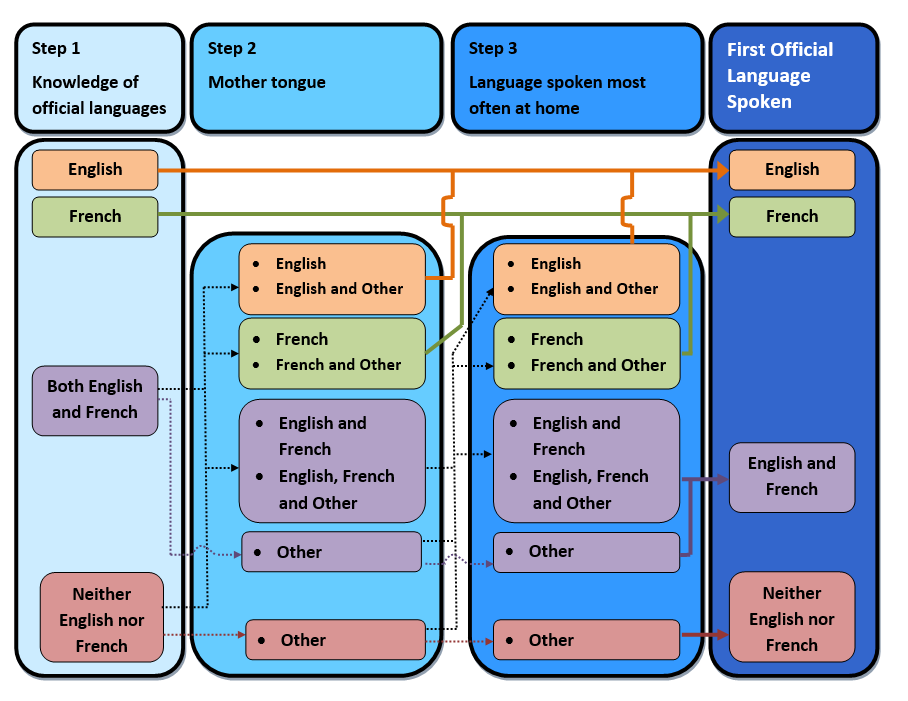

 Diet and nutrition
Diet and nutrition Food manufacturing
Food manufacturing Food prices
Food prices Food production and availability
Food production and availability

